Minnesota Documents
Quitclaim Deed
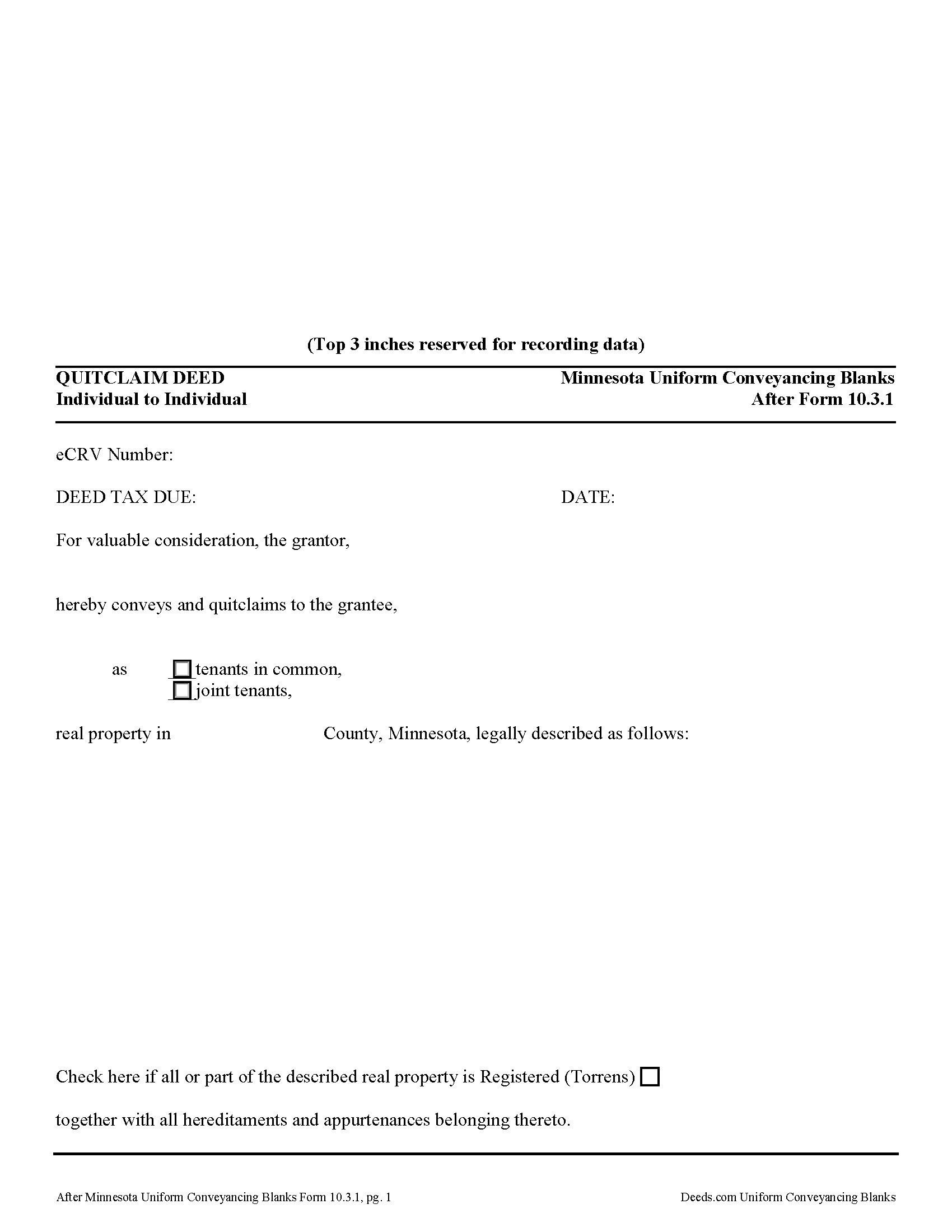
The quitclaim deed from individual to individual (Minnesota Conveyancing Blanks Form 10.3.1) is "sufficient to pass all the estate which the grantor could convey by deed of bargain and sale" in Minnesota (Minn. Stat. 507.06).
The deed conveys to the named grantee "all right, title, and interest of the grantor in the premises described," and does not extend to any after-acquired title ( 507.07). A quitclaim deed contains no warranties of title. For this reason, the quitclaim deed is often used in divorce or other transactions between family members.
Requirements of the form include the names and marital status of each grantor and grantee and a complete legal description of the property subject to transfer. All grantors or grantors' authorized representatives and joining spouses must sign the deed. A state deed tax, the amount of which is cited on the face of the deed is levied on the amount of consideration made for the transfer, and must be paid before the deed can be recorded.
Minnesota requires an electronic certificate of real estate value and a well disclosure statement for all sales of real property.
Ensure the deed meets document recording standards ( 507.093) ... More Information about the Minnesota Quitclaim Deed
Quitclaim Deed from Individual to Joint Tenants
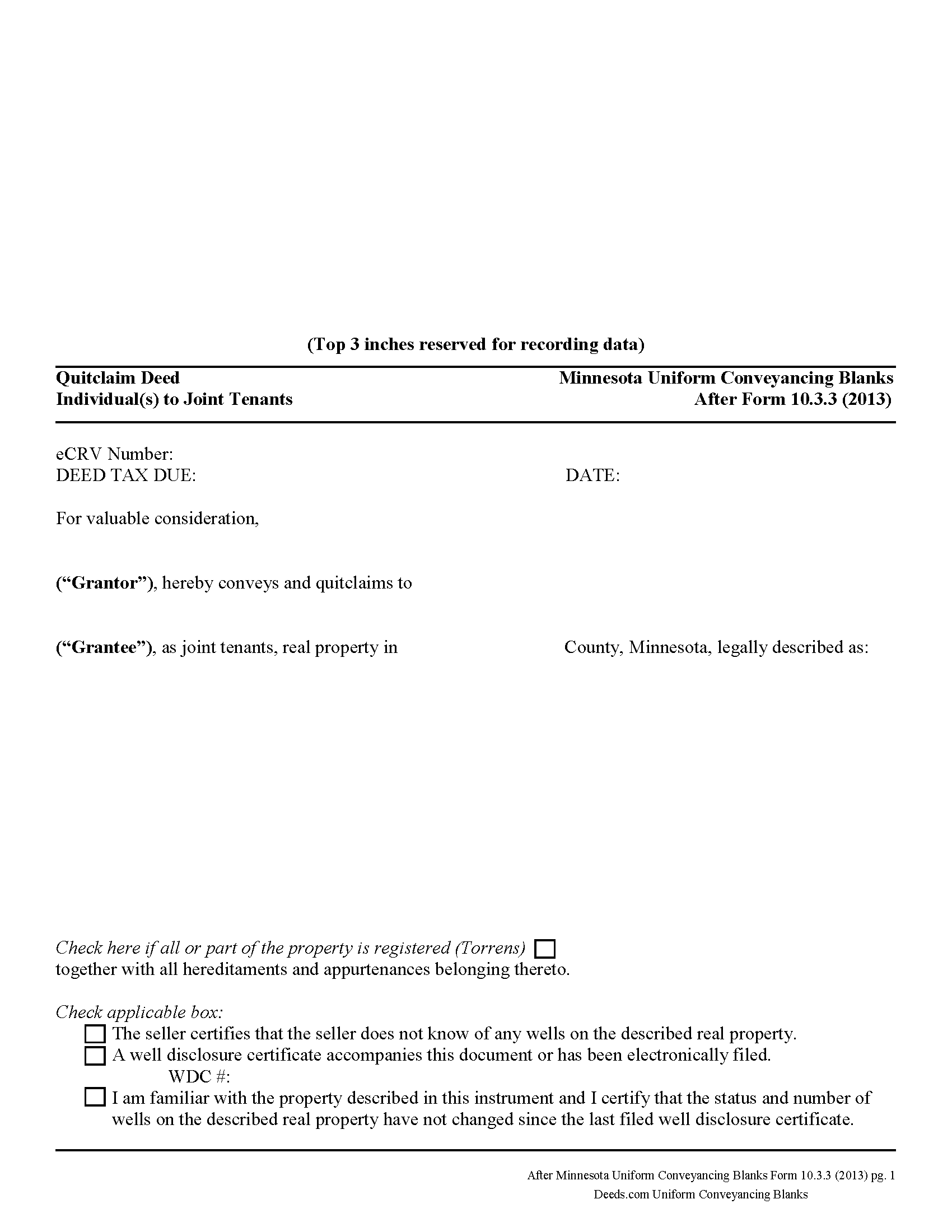
Minnesota's real estate deeds are governed by Minn. Stat. 507, which contains the basic form and requirements for lawful conveyance of property. A quitclaim deed is used in Minnesota real estate transactions where the grantor agrees that "such instrument, duly executed, shall be a conveyance to the grantee, the grantee's heirs and assigns, of all right, title, and interest of the grantor in the premises described, but shall not extend to after acquired title, unless words expressing such intention be added." (507.07). In other words, a quitclaim deed generally transfers only the grantor's current interest, if any, in the property at the time of the deed's execution.
While properly completed statutory form may suffice in many situations, they leave the possibility for errors based on incorrect or missing information. To reduce confusion about the information needed for different real estate transactions, Minnesota suggests guidelines for uniform conveyancing forms, each with a specific purpose. See Minn. Stat. 507.09-507.14.
This quitclaim deed form, specifically intended for real property transfers from individual owner(s) to joint tenants, matches the format, content, and ... More Information about the Minnesota Quitclaim Deed from Individual to Joint Tenants
Quitclaim Deed Divorce
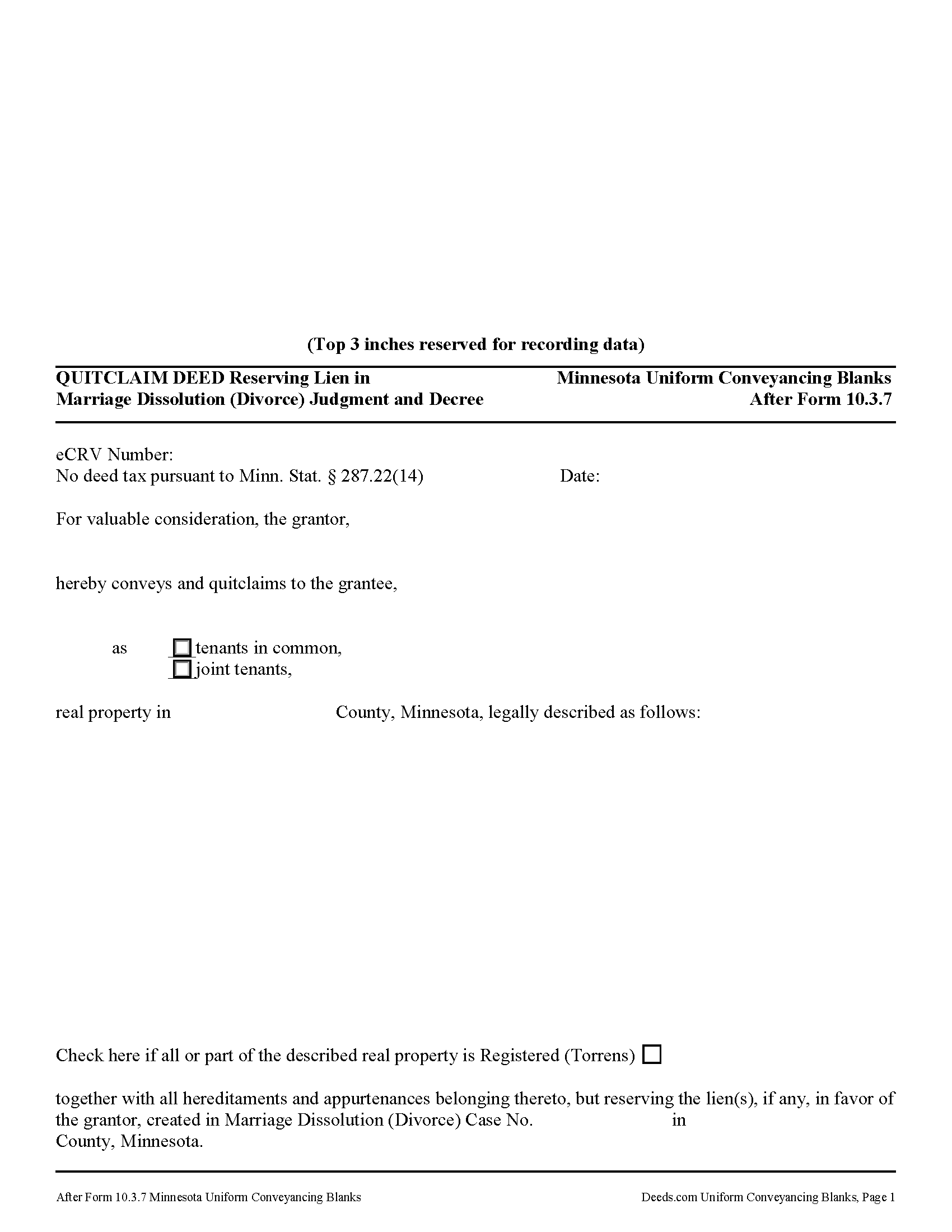
Minnesota Quitclaim Deed Reserving a Lien in Marriage Dissolution
Use this form to transfer title to real property as needed following a decree of dissolution in divorce proceedings.
This form transfers title to the appropriate party and reserves a martial lien, which attaches to the title. Marital liens are used to divide spousal property by preserving a spouse's portion of the homestead's equity or to secure obligations of a spouse.
Use of a quitclaim deed to transfer title pursuant to a judgment and decree of dissolution may follow use of the summary real estate disposition, a statutory form under Minn. Stat. 518.191.
Record the completed deed in the office of the county recorder (or registrar of titles, if registered land) where the subject property is located.
Consult a lawyer with questions.
(Minnesota QCD Divorce Package includes form, guidelines, and completed example)... More Information about the Minnesota Quitclaim Deed Divorce
Gift Deed
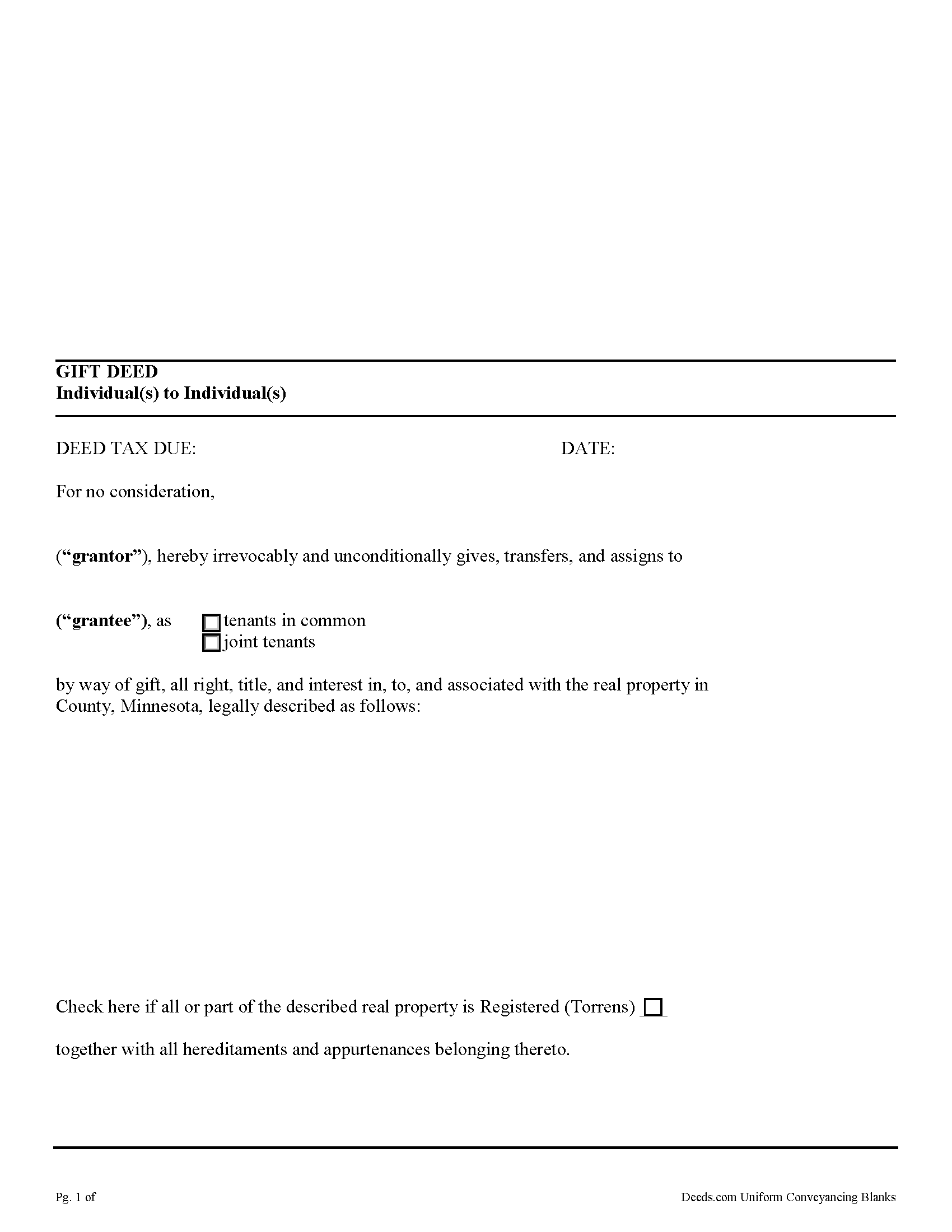
Gifting Real Estate (Real Property) in Minnesota
A gift deed, or deed of gift, is a legal document voluntarily transferring title to real property from one party (the grantor or donor) to another (the grantee or donee). A gift deed typically transfers real property between family or close friends. Gift deeds are also used to donate to a non-profit organization or charity. The deed serves as proof that the transfer is indeed a gift and without consideration (any conditions or form of compensation).
Valid deeds must meet the following requirements: The grantor must intend to make a present gift of the property, the grantor must deliver the property to the grantee, and the grantee must accept the gift. Gift deeds must contain language that explicitly states no consideration is expected or required, because any ambiguity or reference to consideration can make the deed contestable in court. A promise to transfer ownership in the future is not a gift, and any deed that does not immediately transfer the interest in the property, or meet any of the aforementioned requirements, can be revoked [1].
A lawful gift deed must also include the grantor's full name and marital status, a... More Information about the Minnesota Gift Deed
Warranty Deed
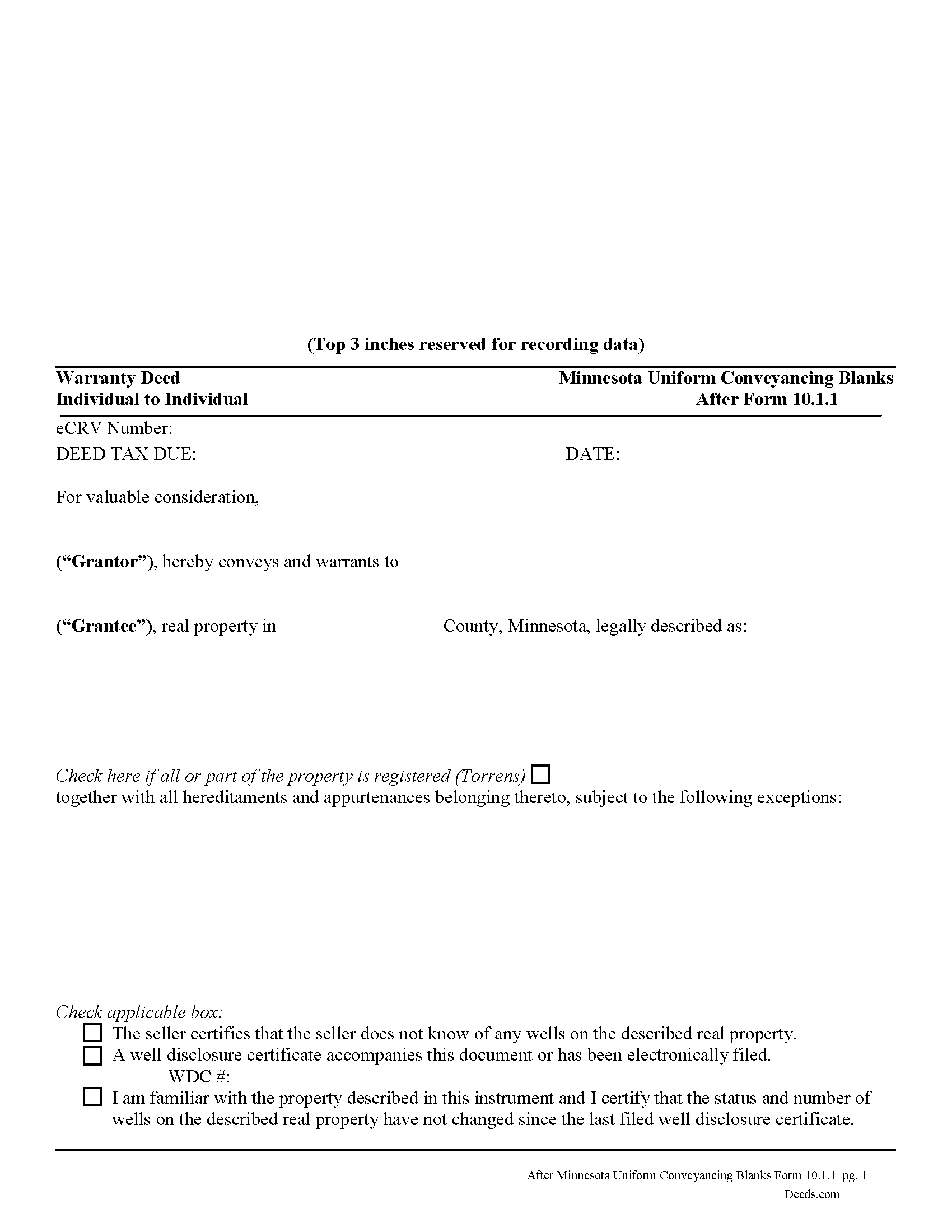
A warranty deed is the customary form for a conveyance of real estate in Minnesota. A duly executed warranty deed includes the following covenants on the part of the grantor: (1) that the grantor is lawfully seized of the premises in fee simple and has good right to convey the property; (2) that the premises are free from all encumbrances; (3) the right to quiet and peaceable possession thereof; and (4) the grantor will defend the title thereto against all persons who may lawfully claim the same.
A warranty deed, in order to be recordable, should include the original signature of the grantor and the notary public or other officer taking acknowledgments (507.24). The acknowledgment must be certified, as required by law. If the warranty deed is executed out of state, it is entitled to be recorded in Minnesota if it is executed as provided by Minnesota laws or according to the laws of the place of execution (507.24). A Certificate of Value should accompany any warranty deed to be recorded in Minnesota. Additionally, a Well Disclosure Certificate, if applicable, should accompany the deed.
A warranty deed should be recorded in the office of the county recorder where the real esta... More Information about the Minnesota Warranty Deed
Warranty Deed Excluding Assessment
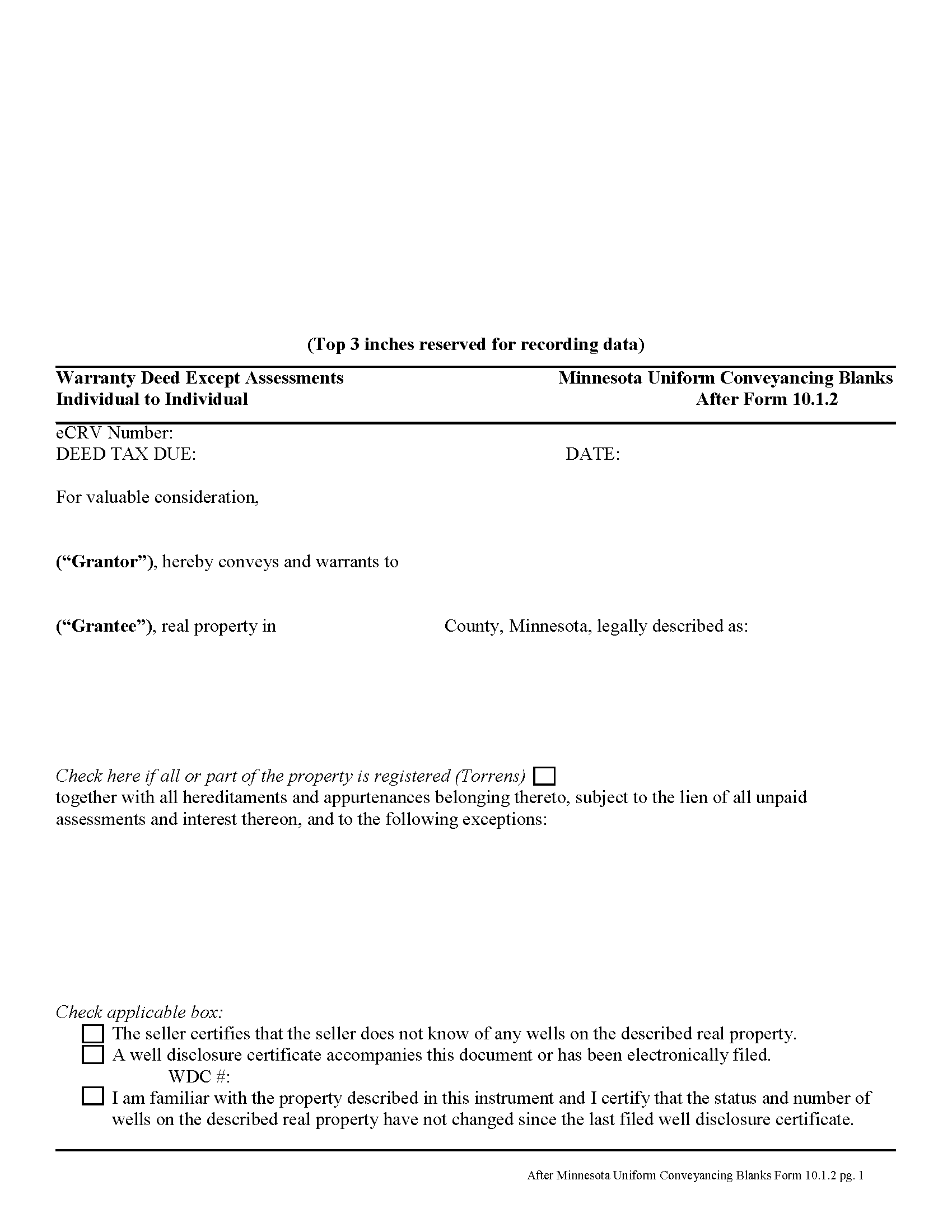
Minnesota's real estate deeds are governed by Minn. Stat. 507. The statutes contain the basic form and requirements for lawful conveyance of property. A warranty deed is used in Minnesota real estate transactions where the grantor agrees that "such instrument, duly executed as required by law, shall be a conveyance in fee simple of the premises described to the grantee, the grantee's heirs and assigns, with covenants on the part of the grantor, the grantor's heirs and personal representatives, that the grantor is lawfully seized of the premises in fee simple and has good right to convey the same; that the premises are free from all encumbrances; that the grantor warrants to the grantee, the grantee's heirs and assigns, the quiet and peaceable possession thereof; and that the grantor will defend the title thereto against all persons who may lawfully claim the same. Such covenants shall be obligatory upon any grantor, the grantor's heirs and personal representatives, as fully and with like effect as if written at length in such deed" (507.07).
While properly completed statutory form may suffice in many situations, they leave the possibility for errors based on incorrect or missin... More Information about the Minnesota Warranty Deed Excluding Assessment
Warranty Deed from Individual to Joint Tenants
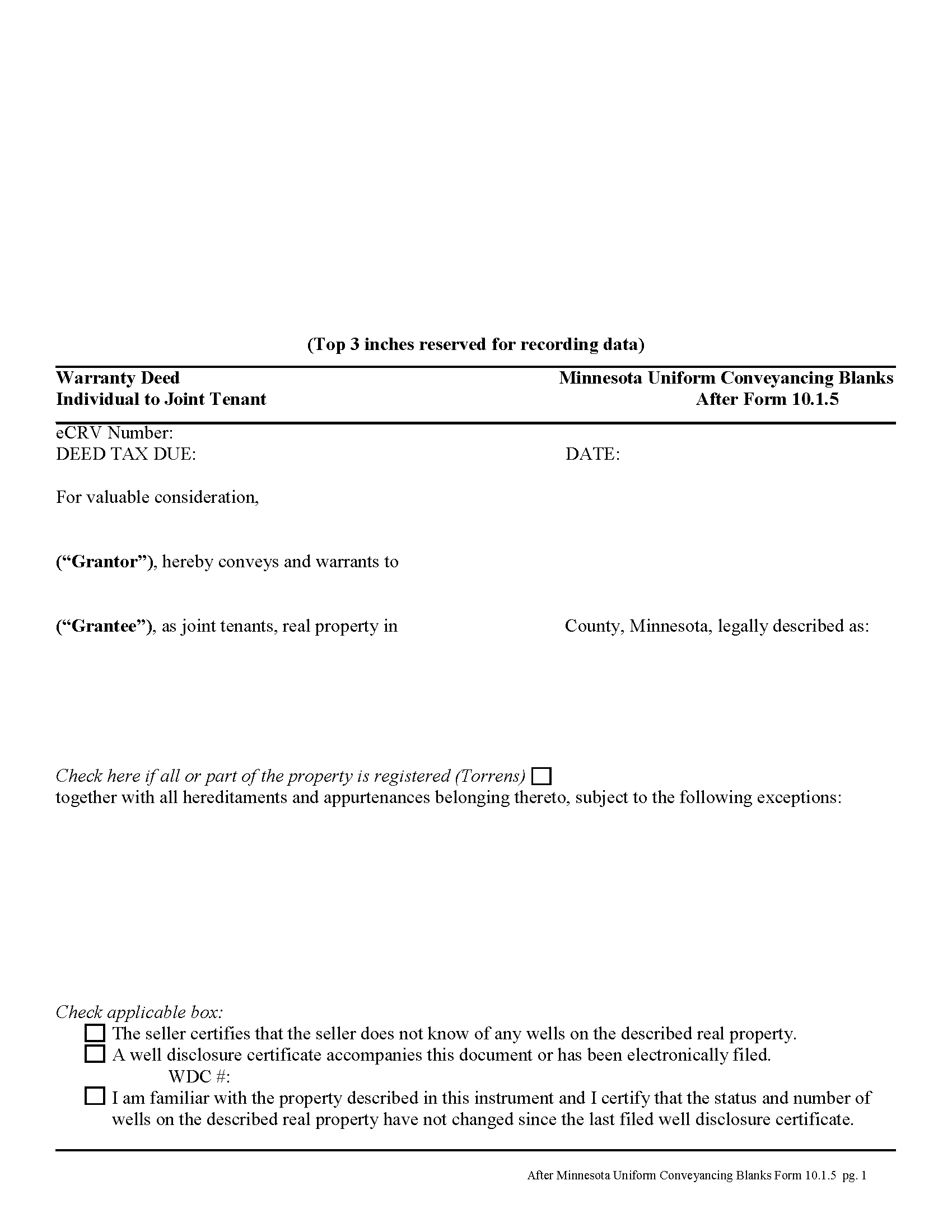
Minnesota's real estate deeds are governed by Minn. Stat. 507.
The statutes contain the basic form and requirements for lawful conveyance of property. A warranty deed is used in Minnesota real estate transactions where the grantor agrees that "such instrument, duly executed as required by law, shall be a conveyance in fee simple of the premises described to the grantee, the grantee's heirs and assigns, with covenants on the part of the grantor, the grantor's heirs and personal representatives, that the grantor is lawfully seized of the premises in fee simple and has good right to convey the same; that the premises are free from all encumbrances; that the grantor warrants to the grantee, the grantee's heirs and assigns, the quiet and peaceable possession thereof; and that the grantor will defend the title thereto against all persons who may lawfully claim the same. Such covenants shall be obligatory upon any grantor, the grantor's heirs and personal representatives, as fully and with like effect as if written at length in such deed" (507.07).
While properly completed statutory form may suffice in many situations, they leave the possibility for errors based on incorrect or mi... More Information about the Minnesota Warranty Deed from Individual to Joint Tenants
Warranty Deed from Individual to Joint Tenants Excluding Assessments
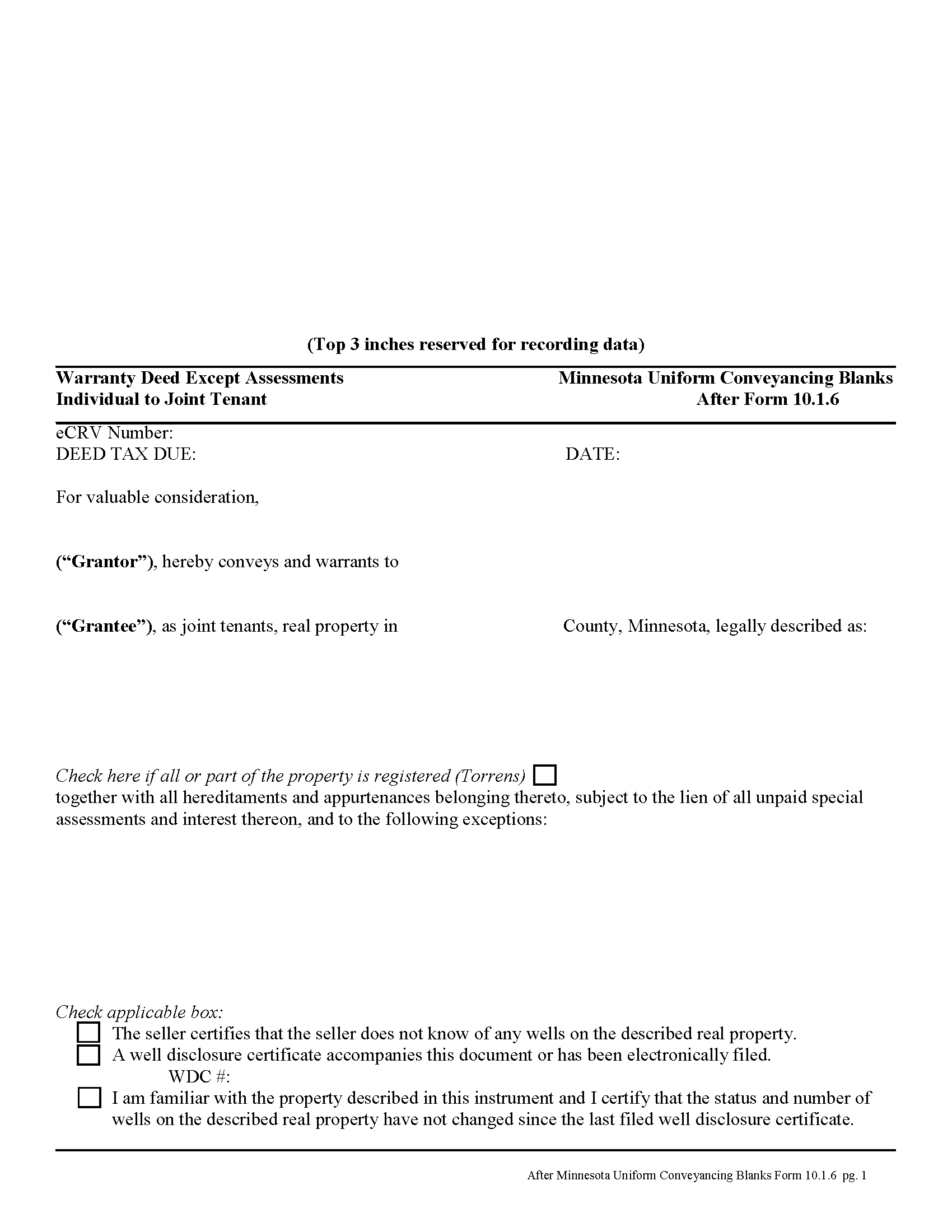
Minnesota's real estate deeds are governed by Minn. Stat. 507.
The statutes contain the basic form and requirements for lawful conveyance of property. A warranty deed is used in Minnesota real estate transactions where the grantor agrees that "such instrument, duly executed as required by law, shall be a conveyance in fee simple of the premises described to the grantee, the grantee's heirs and assigns, with covenants on the part of the grantor, the grantor's heirs and personal representatives, that the grantor is lawfully seized of the premises in fee simple and has good right to convey the same; that the premises are free from all encumbrances; that the grantor warrants to the grantee, the grantee's heirs and assigns, the quiet and peaceable possession thereof; and that the grantor will defend the title thereto against all persons who may lawfully claim the same. Such covenants shall be obligatory upon any grantor, the grantor's heirs and personal representatives, as fully and with like effect as if written at length in such deed" (507.07).
By excluding assessments from the covenants of title, the grantor alerts the grantee to the fact that one or more outstanding assessme... More Information about the Minnesota Warranty Deed from Individual to Joint Tenants Excluding Assessments
Limited Warranty Deed
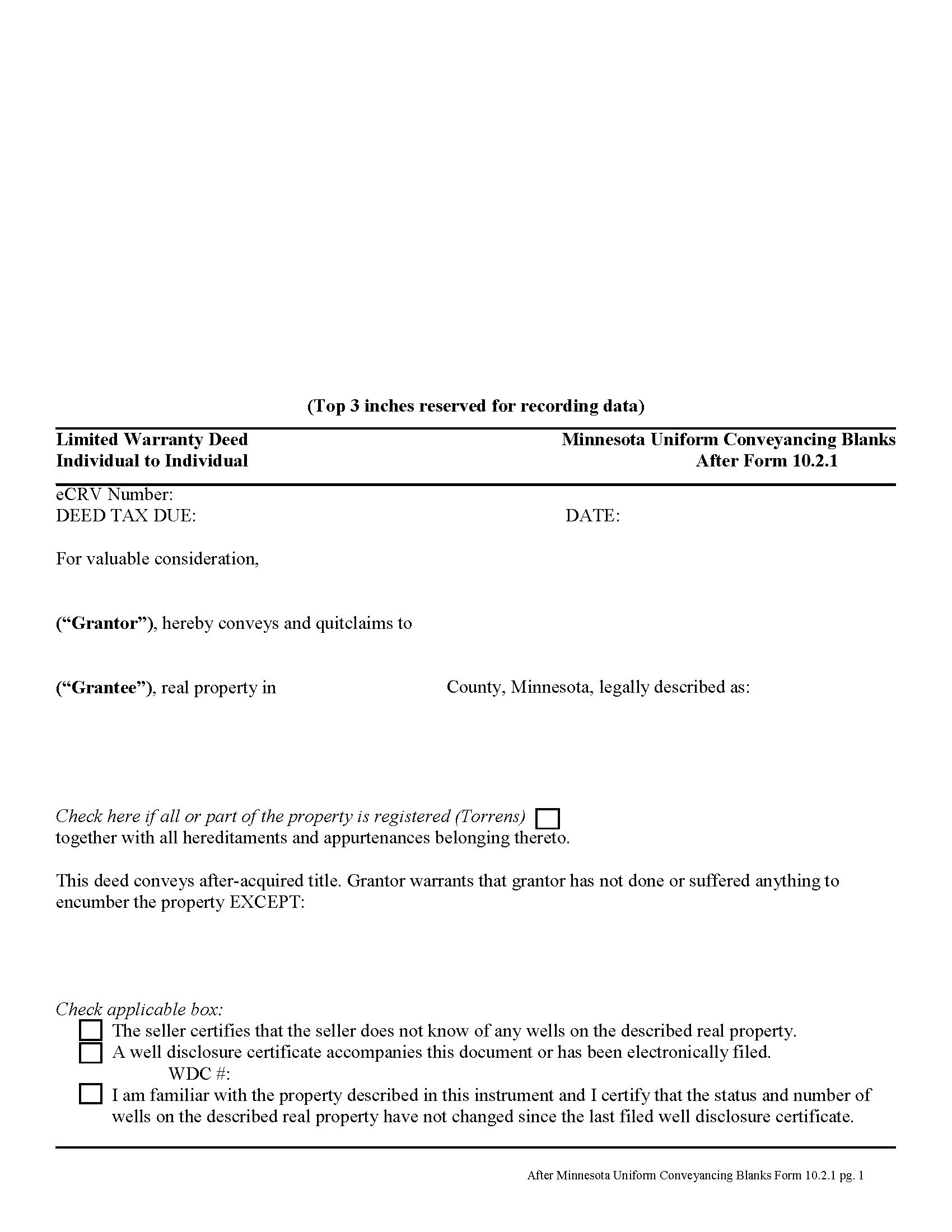
A limited warranty deed can be used in a conveyance of real property in this state. The grantor in a limited warranty deed in Minnesota warrants to the grantee that the grantor has not done or suffered anything to encumber the title, except as may be listed in the deed. According to the Minnesota Statutes, no covenants of title are implied in a conveyance, whether the conveyance contains special covenants or not, except for the covenants included in a warranty deed (507.16).
In a deed of real estate upon which any encumbrance exists, the grantor shall make known to the grantee the existence and nature of such encumbrance, so far as the grantor has knowledge of. This is to be done before any consideration is paid (507.20).
To entitle a limited warranty deed to be recorded with the county recorder or registrar of titles, it must be executed and acknowledged by the parties executing it. The acknowledgment must be certified, as required by law. In addition, the original signatures of the parties executing the instrument must be present on the deed, as well as the original signature of the notary public or other officer taking acknowledgments. If the warranty deed is executed out... More Information about the Minnesota Limited Warranty Deed
Limited Warranty Deed Excluding Assessment
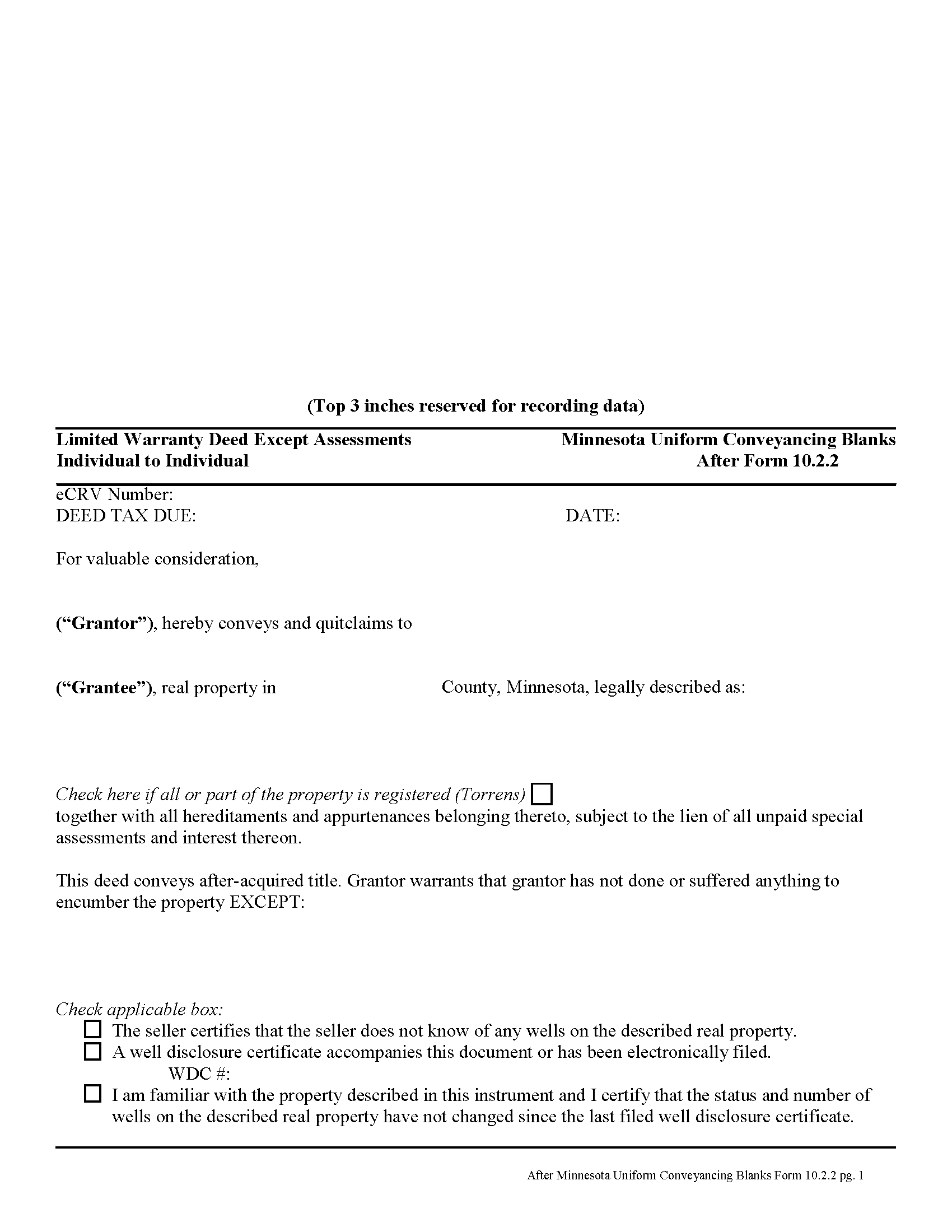
A limited warranty deed is used for Minnesota real estate transactions where the grantor agrees to guarantee that, during the time of ownership, the grantor did nothing to encumber the property. The deed also passes after-acquired title (any future rights the grantor gains to the same land transferred by the deed).
By excluding assessments from the covenants of title, the grantor alerts the grantee to the fact that one or more outstanding assessment liens and any associated interest may still be attached to the title.
(Minnesota LWD Excluding Assessment Package includes form, guidelines, and completed example)... More Information about the Minnesota Limited Warranty Deed Excluding Assessment
Limited Warranty Deed from Individual to Joint Tenant
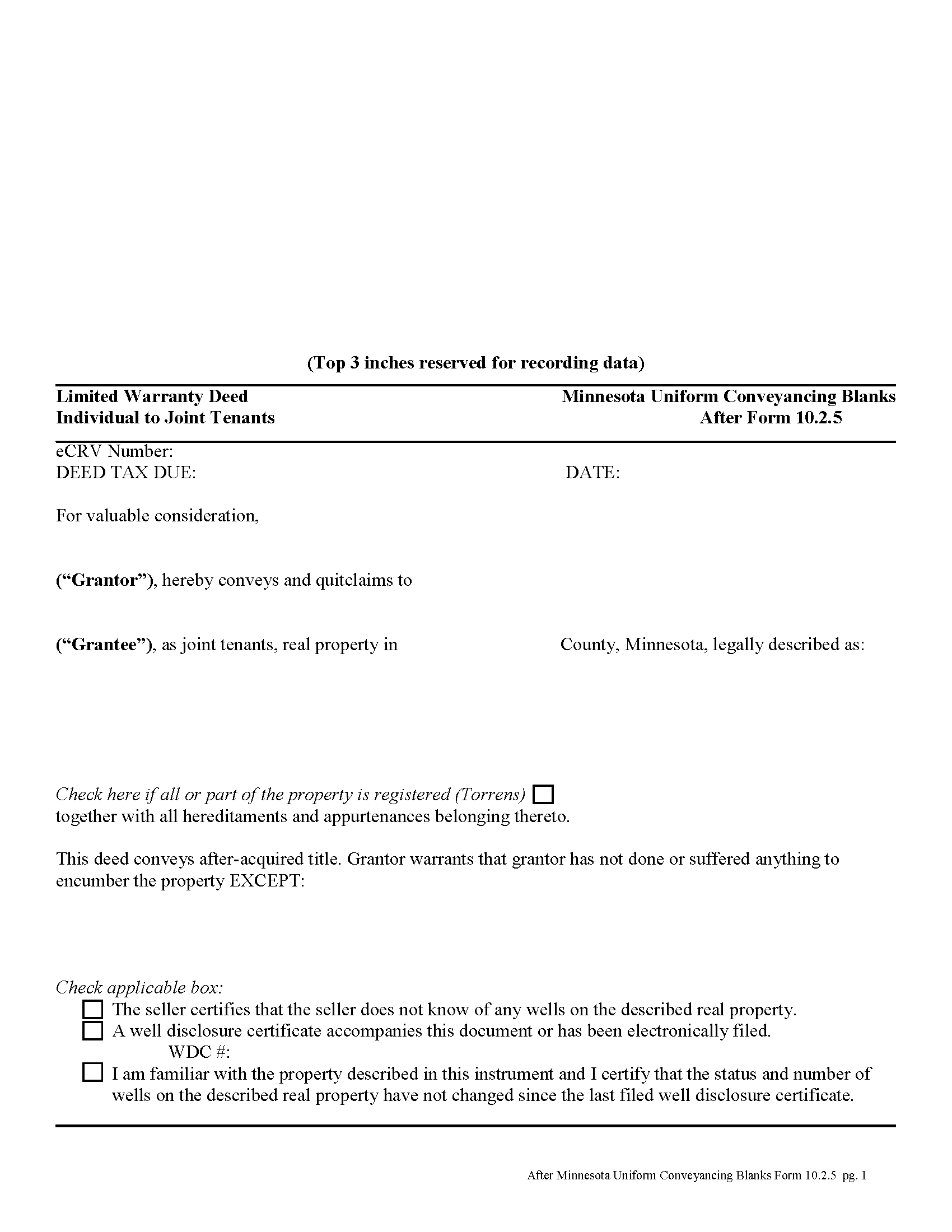
A limited warranty deed is used for Minnesota real estate transactions where the grantor guarantees that, during the time of ownership, the grantor did nothing undisclosed to encumber the land. The deed also passes after-acquired title (any future rights the grantor gains to the same land transferred by the deed).
The basic forms and requirements for real estate deeds in Minnesota are governed by Minn. Stat. 507. Properly completed statutory deeds are effective in most cases, but leave room for errors based on incorrect or missing information. To reduce confusion about the different real estate transactions, Minnesota suggests requirements for uniform conveyancing forms, each with a specific purpose.
This deed form, specifically intended for real property transfers from individual owner(s) to joint tenants, matches the format, content, and requirements set forth in the most recent update.
(Minnesota LWD Ind to JT Package includes form, guidelines, and completed example)... More Information about the Minnesota Limited Warranty Deed from Individual to Joint Tenant
Limited Warranty Deed from Individual to Joint Tenant Excluding Assessment
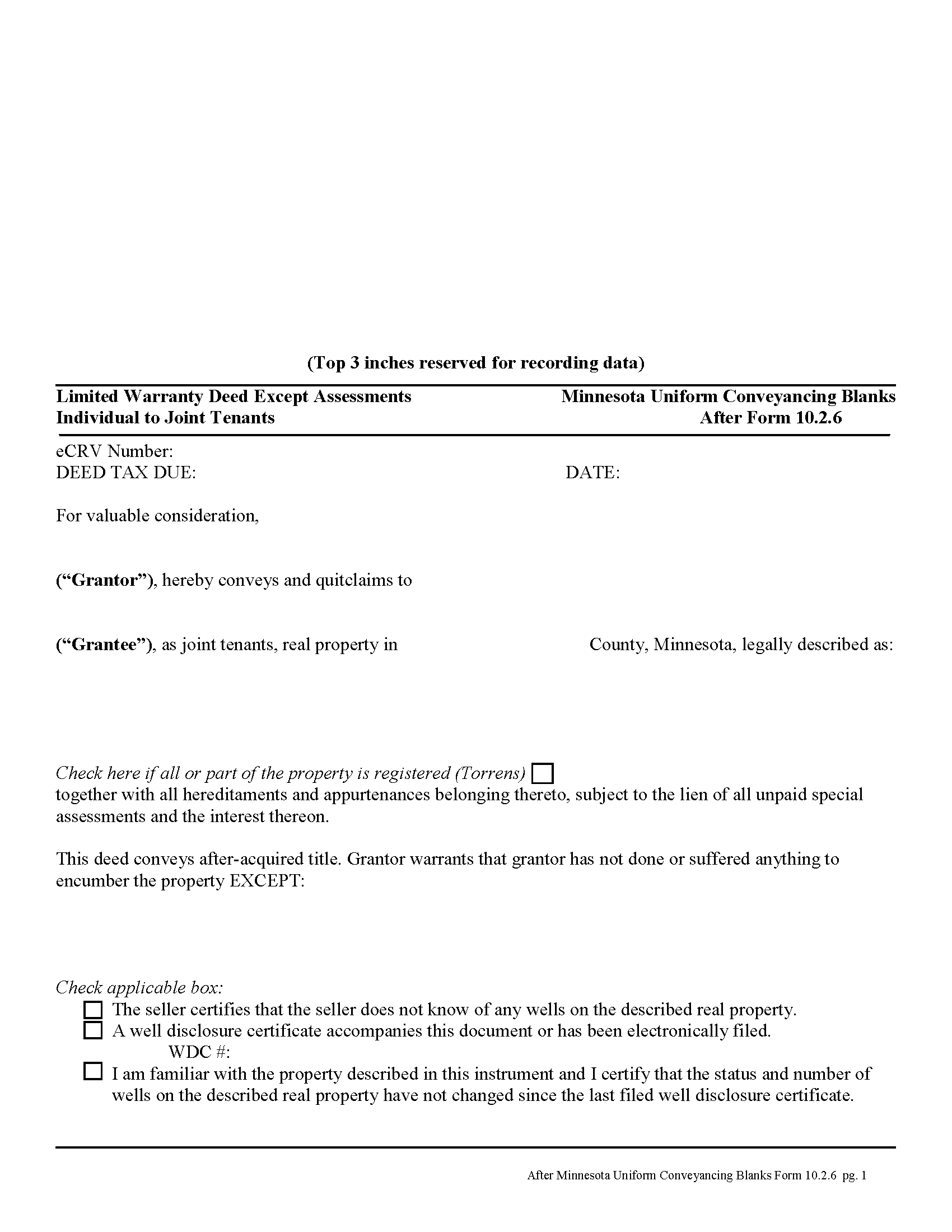
A limited warranty deed is used in Minnesota real estate transactions where the grantor guarantees that, during the time of ownership, the grantor did nothing undisclosed to encumber the land. The deed also passes after-acquired title (any future rights the grantor gains to the same land transferred by the deed).
By excluding assessments from the covenants of title, the grantor alerts the grantee to the fact that one or more outstanding assessment liens and any associated interest may still be attached to the title.
The basic forms and requirements for real estate deeds in Minnesota are governed by Minn. Stat. 507. Properly completed statutory deeds are effective in most cases, but leave the possibility for errors based on incorrect or missing information. To reduce confusion about the different real estate transactions, Minnesota suggests requirements for uniform conveyancing forms, each with a specific purpose.
This deed form, specifically intended for real property transfers from individual owner(s) to joint tenants, matches the format, content, and requirements set forth in the most recent update.
(Minnesota LWD Ind to JT Excluding Assessment Package includes form,... More Information about the Minnesota Limited Warranty Deed from Individual to Joint Tenant Excluding Assessment
Easement Deed
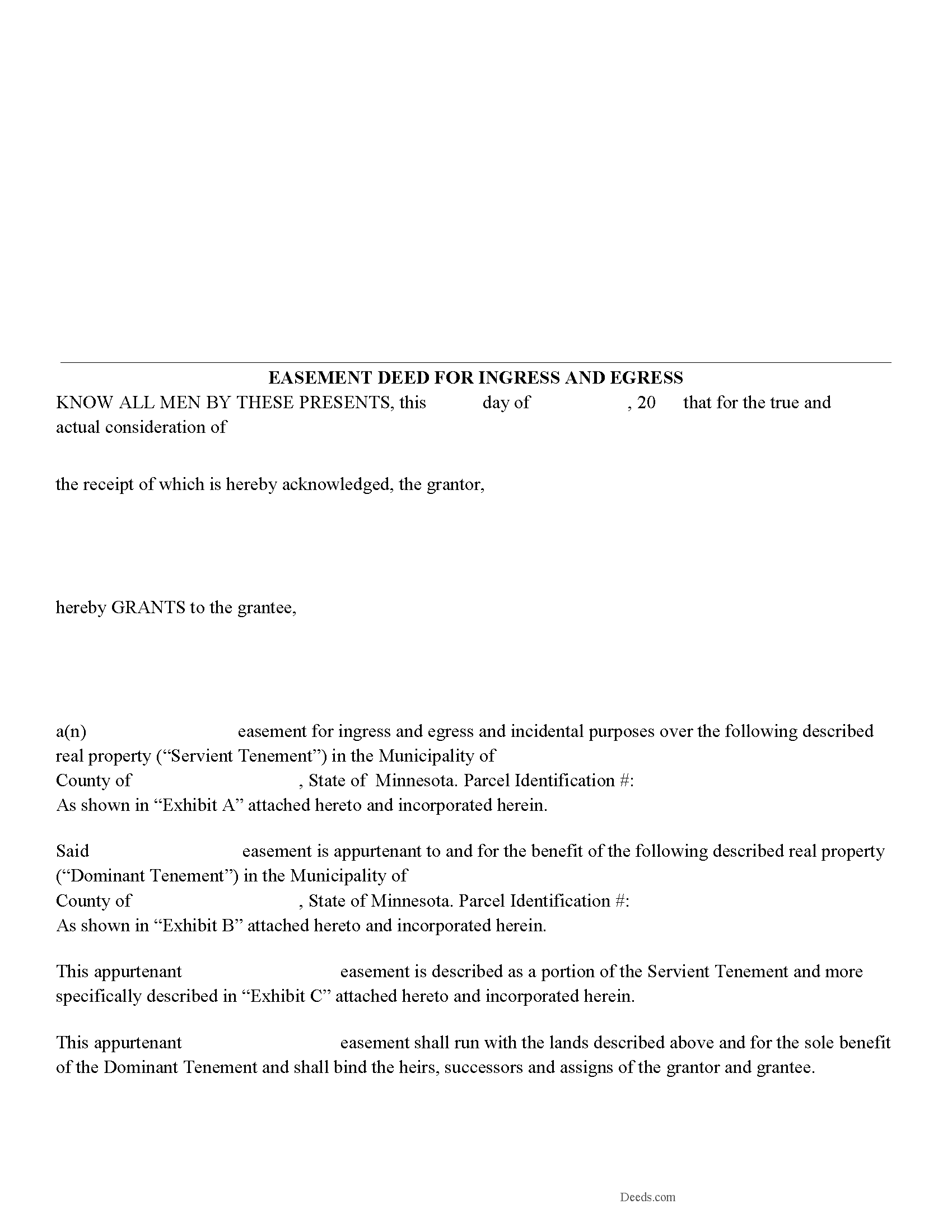
An easement can give one person the right to use another person's real property for a specific purpose. This non-possessory and non-ownership right is created by the easement deed. In Minnesota, a conveyance of all or any portion of real property includes any benefits and burdens of all easements, conditions, restrictions, or other servitudes validated under 507.47, except as provided in sections 500.20 and 541.023 (507.47).
A plat that has been prepared and recorded in accordance with section 505.01 of the Minnesota Statutes can be used to indicate the dedication of easements for public ways, utility easements, and drainage easements (500.01).
An easement is either appurtenant or in gross. An appurtenant easement benefits the dominant estate and runs with the land, whereas an easement in gross benefits an individual or a legal entity. Further, solar easements and wind easements can also be created under Minnesota law (500.30). These easements are granted in the same manner and with the same effect as a conveyance of an interest in real property.
In order for an instrument affecting Minnesota real estate, such as an easement deed, to be eligible for recordation, it should ... More Information about the Minnesota Easement Deed
Termination of Easement
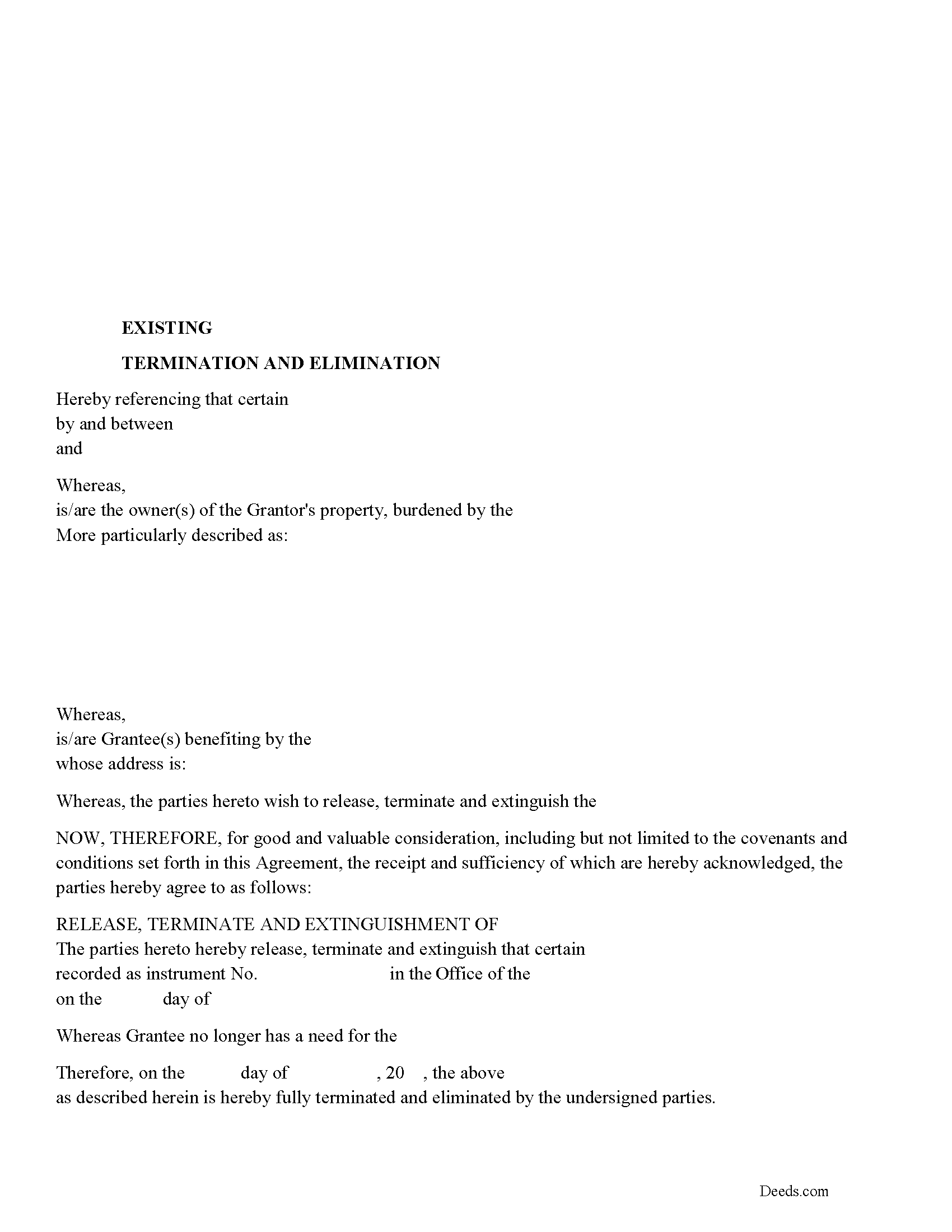
Use this form to release, terminate, extinguish a previously recorded document that involves access to and from a property.
Documents such as:
1. Easement Deeds or Agreements (An easement is a non-possessory interest in land, granting the right to use someone else's property for a specific purpose, like a driveway or utility line)
2. Access Roads
3. Right of Ways
4. Utility Easements (Power, Gas, Water, Sewer, Etc.)
5. Drainage Easements
This document allows the owner of the land, burdened by the access and the party that benefits from the access, to sign an agreement releasing the property from such access, ... More Information about the Minnesota Termination of Easement
Affidavit of Identity and Survivorship
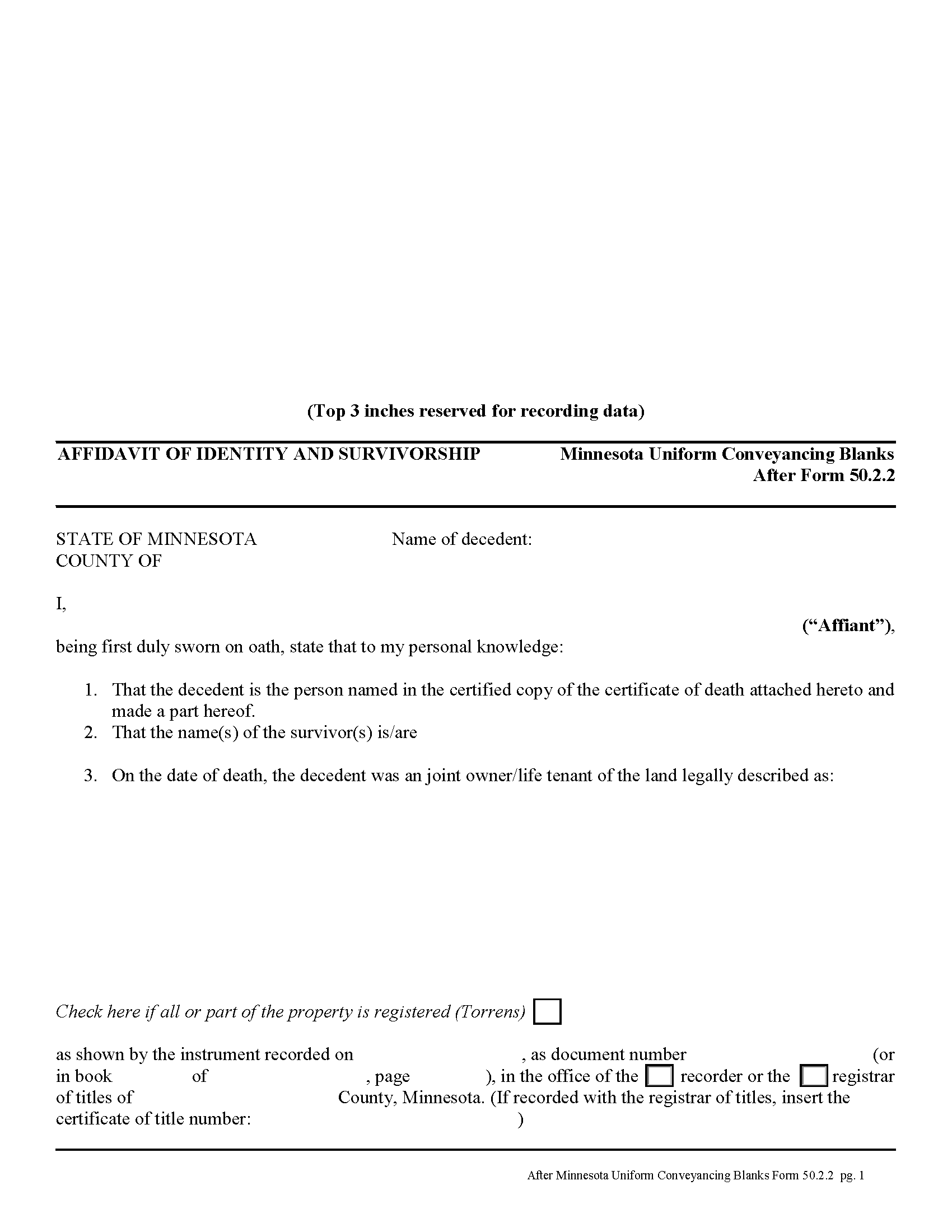
Minnesota allows two or more people to share ownership of real estate as joint tenants. Unlike tenants in common, who each own individual portions of the property, joint tenants share equal parts of the undivided whole property. As a result, if one joint tenant dies, his/her rights are distributed evenly amongst the surviving joint tenants. Note that joint tenancy property passes outside of probate, so it does not become part of the decedent's estate.
To complete the transfer of ownership rights, the surviving joint tenant or tenants should execute an affidavit of identity and survivorship, based on Minnesota Form 50.2.2. The affidavit references the recorded deed where the joint tenants gained the property rights, and also requires a certified copy of the decedent's death certificate. Record the affidavit and its supporting documents in the office responsible for maintaining property records for the county where the land is located.
After recording the affidavit, the deceased joint tenant no longer holds any property rights, but his/her name will still appear as an owner in the records. To actually remove that name, the remaining joint tenant(s) should execute a new deed l... More Information about the Minnesota Affidavit of Identity and Survivorship
Transfer on Death Deed
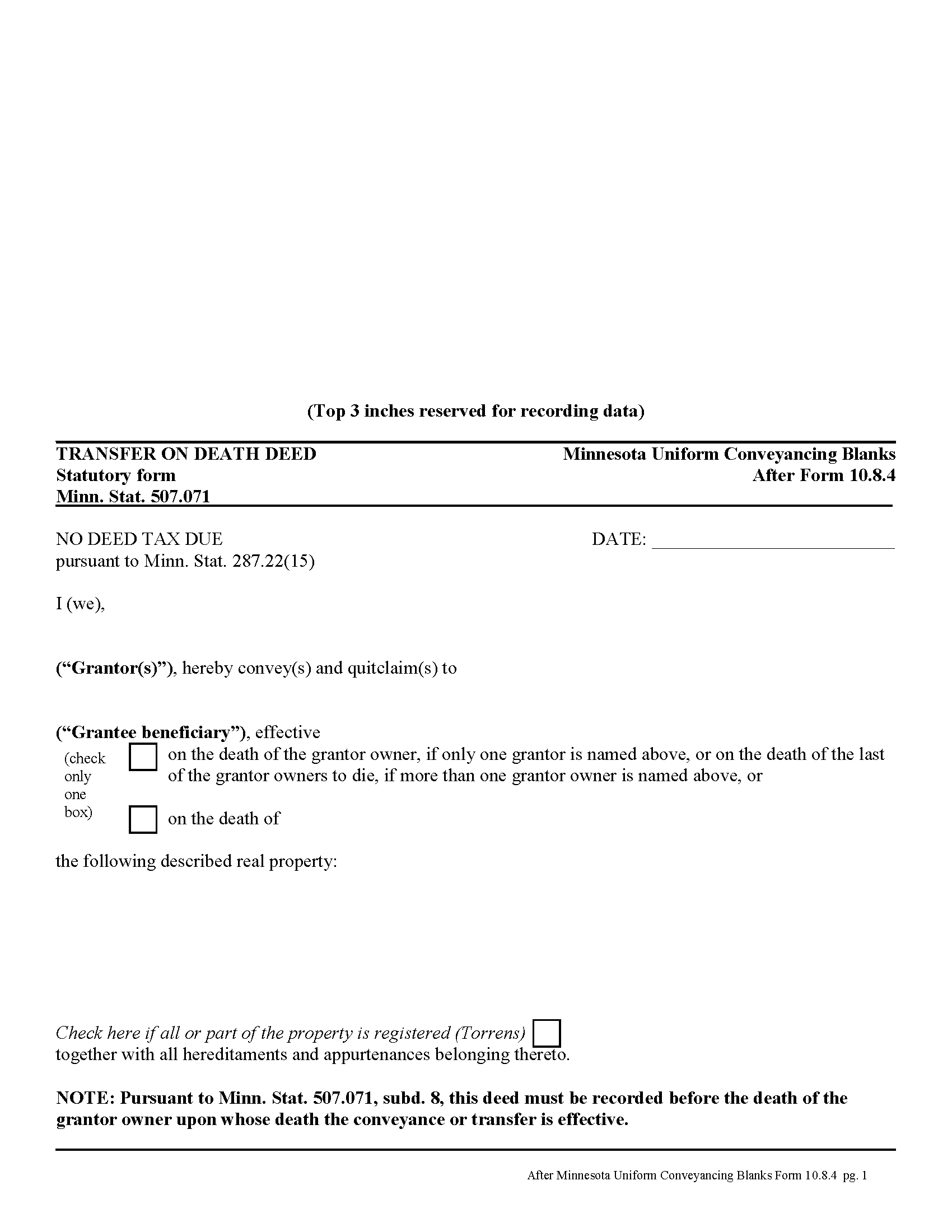
Minnesota's transfer on death deeds are governed by Minn. Stat. 507.071.
Transfer on death deeds are useful estate planning tools for owners of Minnesota real estate. In most cases, when a land owner dies, his/her real property enters the probate system along with the rest of the estate. Some people avoid probate by owning property as joint tenants. The nature of joint tenancy includes the right of survivorship, which, by function of law, automatically distributes a deceased joint tenant's title rights to the surviving tenants. Joint tenants, however, share a current interest in the real property, and all owners must execute any changes or reconveyances. By executing and recording a transfer on death deed instead, owners still avoid the need for probate distribution of that portion of their assets. Transfer on death deeds do NOT pass a current or future interest in the property, so the owner's interests are fully protected while he/she remains alive.
Unlike most other real estate deeds, transfer on death deeds do not convey any rights or interests to the beneficiaries until the grantor owner's death. But, under Minn. Stat. 524.2-702, named beneficiaries must outlive the gran... More Information about the Minnesota Transfer on Death Deed
Transfer on Death Revocation
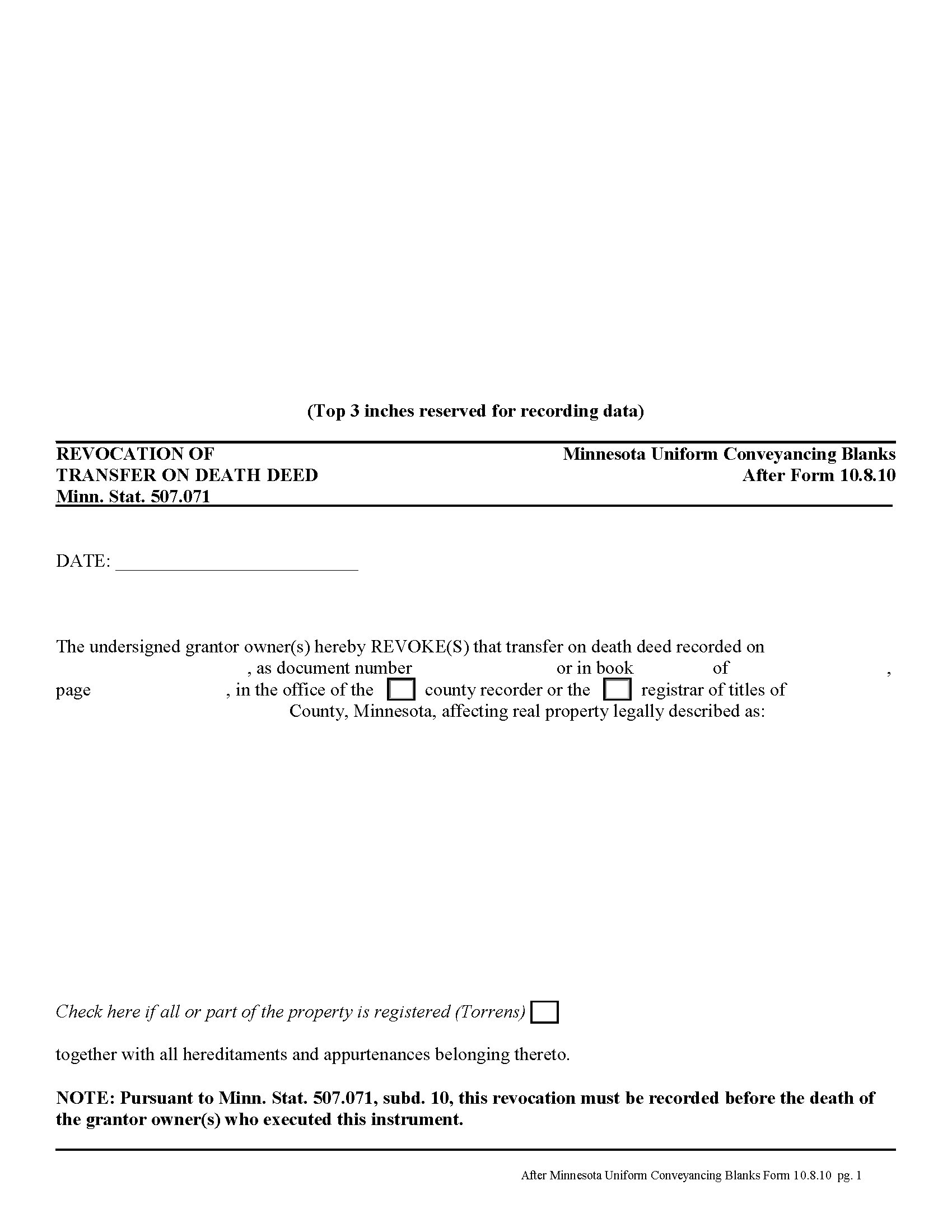
Minnesota's transfer on death deeds are governed by Minn. Stat. 507.071.
Transfer on death deeds offer an excellent alternative for people who wish to designate a beneficiary for their real estate, while remaining outside the complexity of the probate process. Life is unpredictable, however, and the grantor owner of the property might wish to change or revoke the previously recorded transfer on death deed. The same statute covering the deed also includes a section about revoking it (subd. 10).
There are several ways to revoke a transfer on death deed in Minnesota:
1. Complete and record a statutory revocation form (subd. 25). This is the source for the general revocation form. The statute states that a transfer on death deed "may be revoked at any time by the grantor owner or, if there is more than one grantor owner, by any of the grantor owners. To be effective, the revocation must be recorded in the county in which at least a part of the real property is located before the death of the grantor owner or owners who execute the revocation." The revocation is not effective . . . until the revocation is recorded in the county in which the real property is located.
2. Minn... More Information about the Minnesota Transfer on Death Revocation
Affidavit of Identity and Survivorship for Transfer on Death Deeds
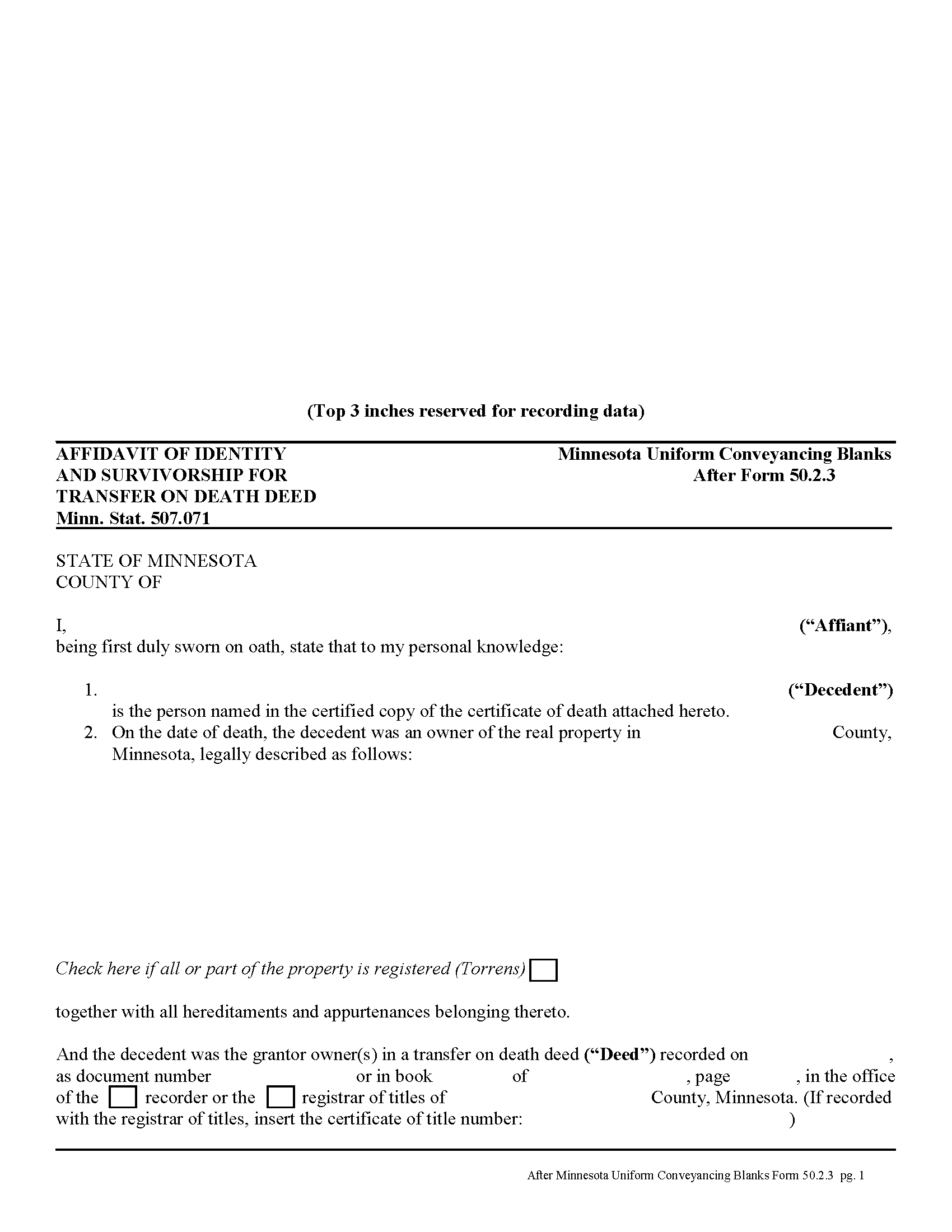
Affidavit of Identity and Survivorship for Transfer on Death Deeds -- Minnesota Form 50.2.3
Minnesota's transfer on death deeds are governed by Minn. Stat. 507.071.
To complete the transfer of property rights after the grantor owner's death, the beneficiary must file an affidavit of identity and survivorship in the county where the land is located (subd.20). The affidavit must contain details about the deceased grantor owner, all beneficiaries, surviving or deceased, a legal description of the real estate, recording information from the transfer on death deed, and the address of the individual or entity who should receive future tax statements.
In addition to the affidavit, include an official copy of the grantor owner's death certificate and a clearance certificate from the Minnesota Department of Human Services. All three forms are required, and may be filed as a unified document with references on the affidavit to the death certificate and clearance certificate, but each may also be recorded individually. Note that the transfer is not completed until all three forms are filed for record.
The beneficiary may complete an online request from the DHS website: https://e... More Information about the Minnesota Affidavit of Identity and Survivorship for Transfer on Death Deeds
Deed of Distribution
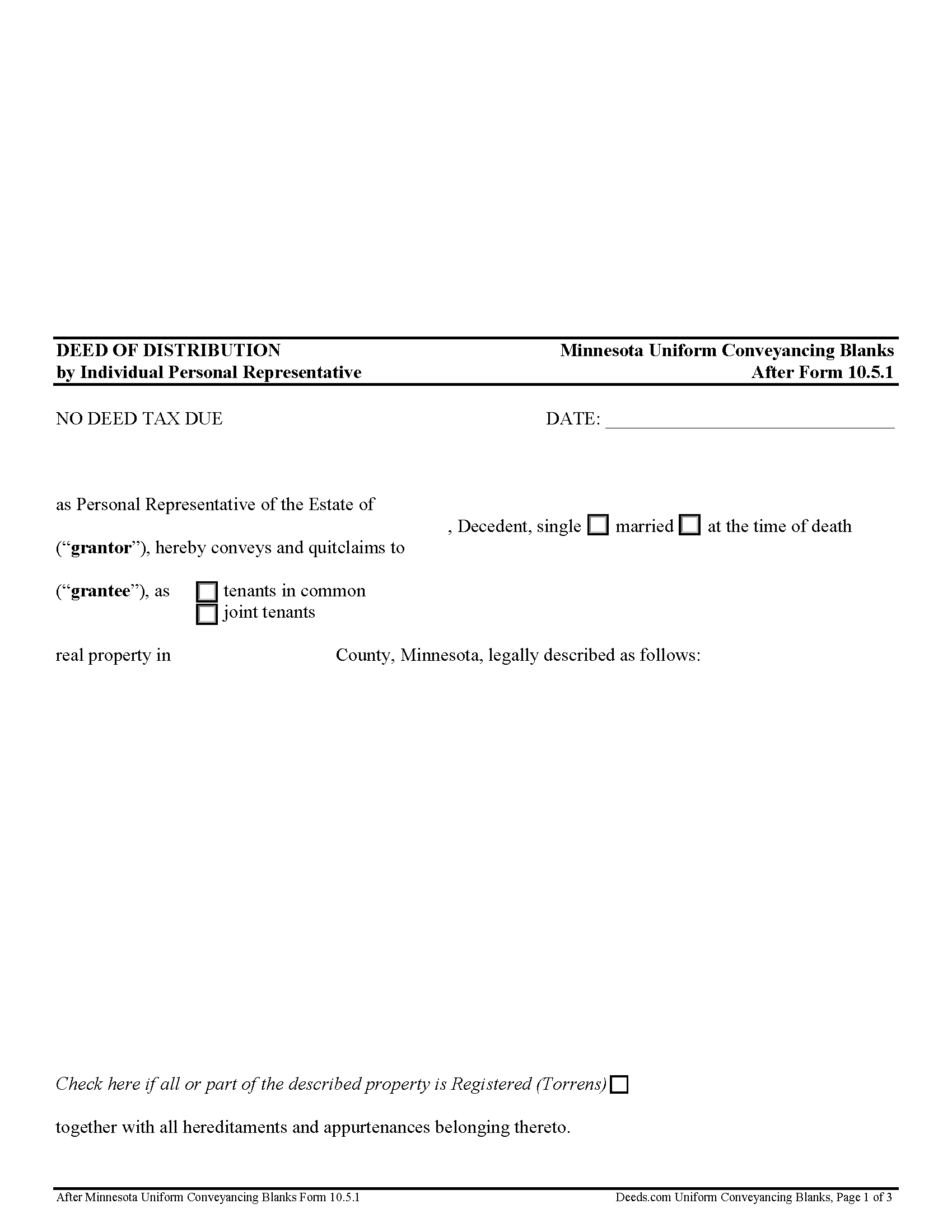
The personal representative's deed of distribution is a fiduciary instrument used in probate proceedings as evidence that a distributee has succeeded to the decedent's interest in real property ( 524.3-908). A personal representative, who may also be referred to as either an executor or administrator, is the fiduciary appointed to manage the decedent's estate.
After Minnesota Conveyancing Blanks Form 10.5.1, use this deed to make a distribution of real property from an individual personal representative (as opposed to a business entity personal representative) with no warranty.
See Minnesota Courts General Practice Rule 410 for requirements for transfers of real estate, and contact a lawyer with questions regarding estate administration and deeds of distribution in Minnesota.
(Minnesota DOD Package includes form, guidelines, and completed example)... More Information about the Minnesota Deed of Distribution
Personal Representative Deed of Sale
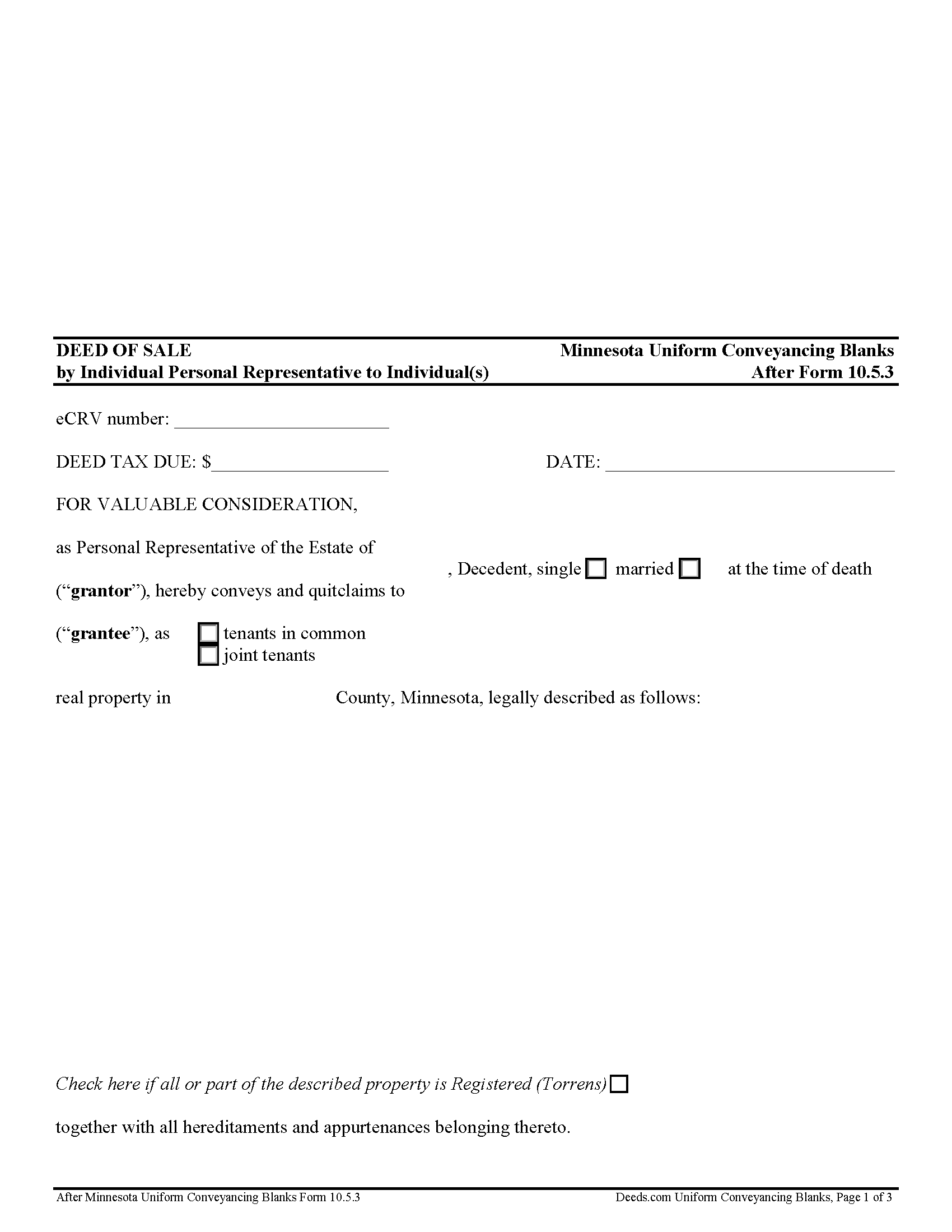
The personal representative's (PR) deed of sale is a fiduciary instrument used in probate proceedings to convey real property from an estate to a purchaser. A personal representative, who may also be referred to as either an executor or administrator, is the fiduciary appointed to manage the decedent's estate.
Formatted after Minnesota Uniform Conveyancing Blanks Form 10.5.3, use this deed to convey the decedent's real property from an individual PR to an individual purchaser when a necessary partition among multiple beneficiaries cannot be conveniently made, to facilitate payment of the estate's debts, or as directed by the decedent's will. The deed carries no warranty.
See Minnesota Courts General Practice Rule 410 for requirements for Transfers of Real Estate, and contact a lawyer with questions regarding estate administration and personal representative's deeds of sale in Minnesota.
(Minnesota Personal Representative DOS Package includes form, guidelines, and completed example)... More Information about the Minnesota Personal Representative Deed of Sale
Transfer on Death Deed by Married Joint Tenants
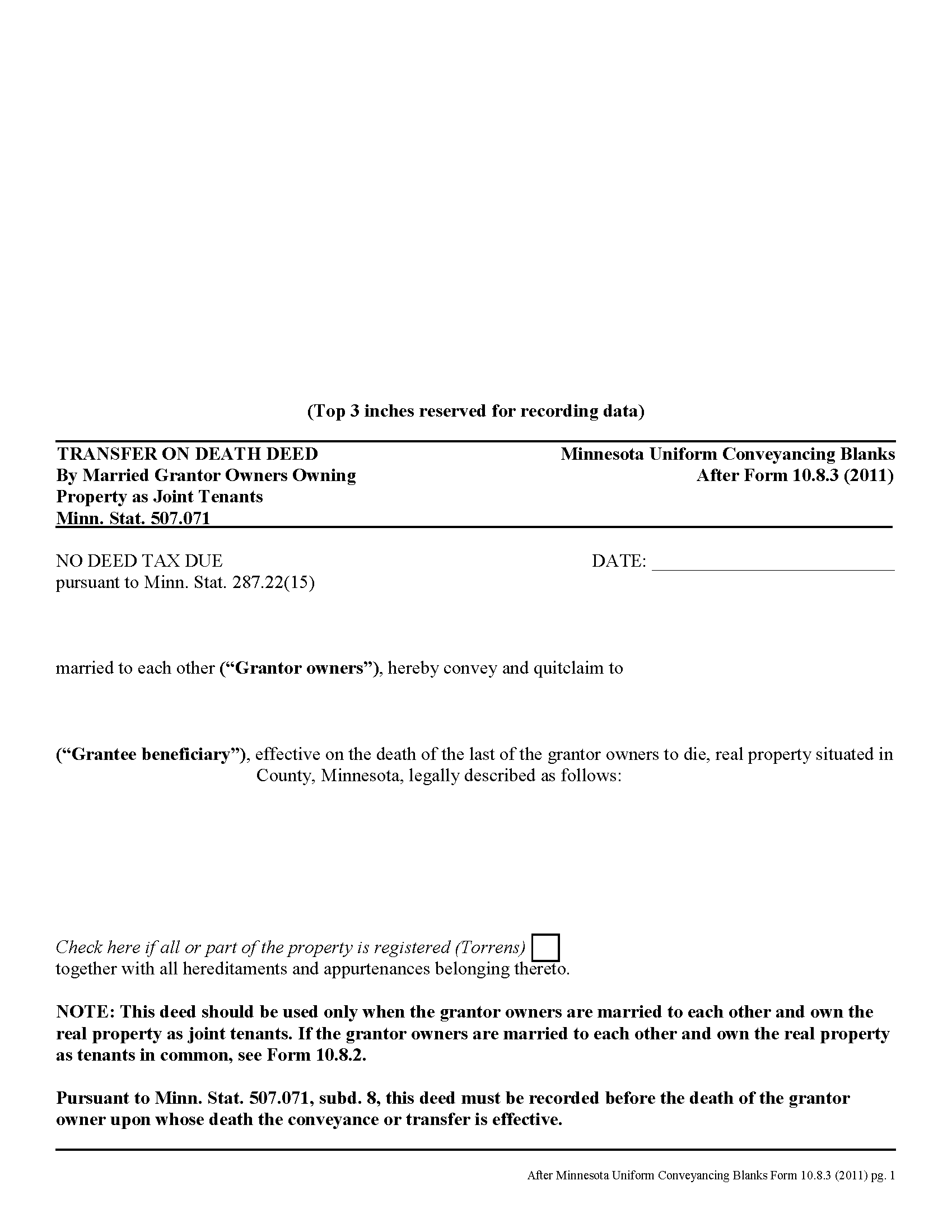
In Minnesota, transfer on death deeds are governed by Minn. Stat. 507.071.
While the statute provides a basic form, as well as overall content requirements, the state authorized the development of uniform conveyance documents for some specific situations. Transfer on death deeds are useful estate planning tools for those who wish to pass real estate down to designated beneficiaries, outside of the probate process.
Mistakes or omissions in such deeds can force the property back into the estate and subject it to probate distribution, despite the grantor owner's best intentions. For example, the rules for joint tenants who wish to convey property with a transfer on death deed are found in 507.071, subd. 6. A correctly-completed basic statutory form is effective in many cases, but because joint tenants are often married to one another, and to ensure that all the required information is included, there is a special deed for this circumstance.
This transfer on death deed form is for use ONLY by married grantor owners who hold title as joint tenants.
As with other transfer on death deeds, this form must be executed and RECORDED during the grantor owner's lifetime.
(Min... More Information about the Minnesota Transfer on Death Deed by Married Joint Tenants
Transfer on Death Deed by Married Sole Owner
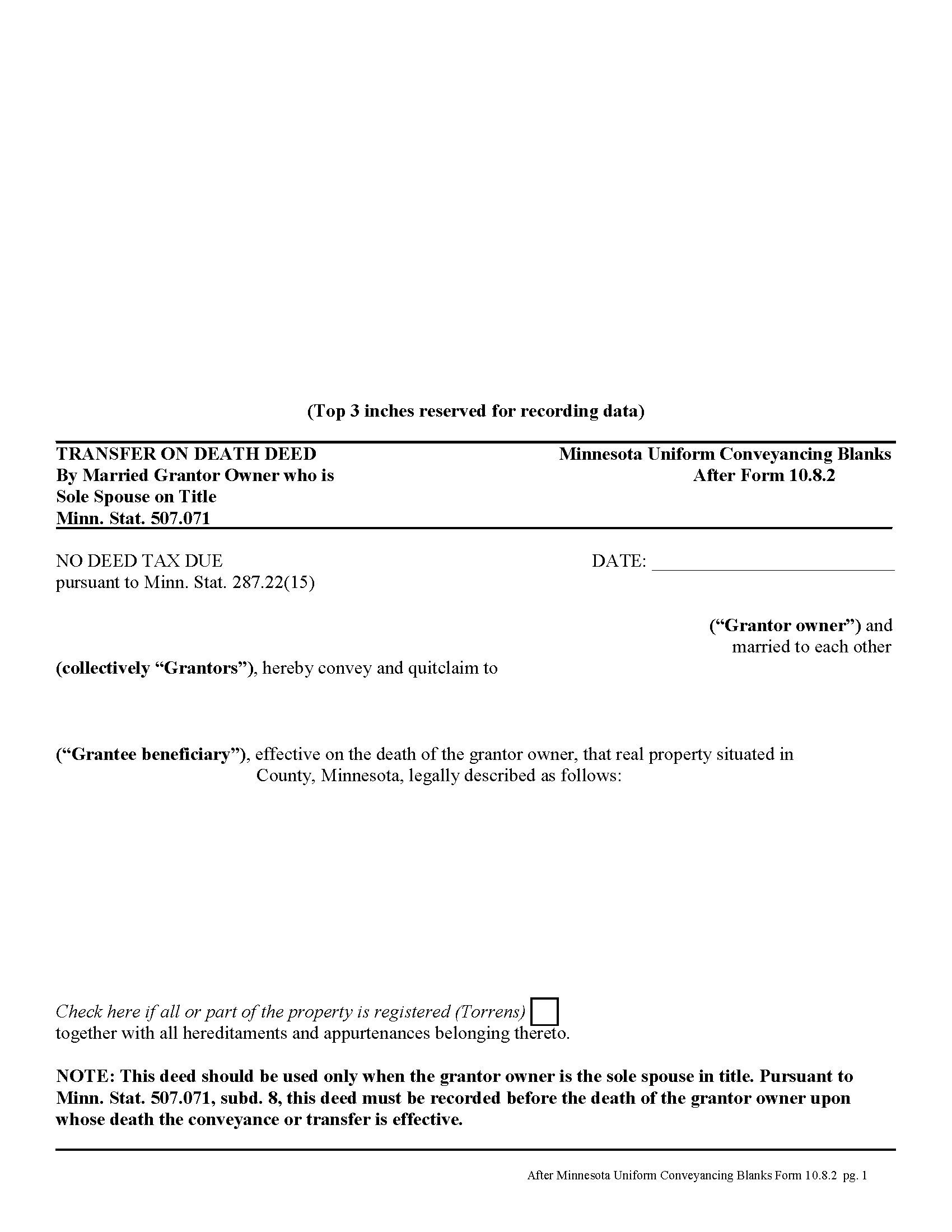
In Minnesota, transfer on death deeds are governed by Minn. Stat. 507.071.
While the statute provides a basic form, as well as overall content requirements, the state authorized the development of uniform conveyance documents for some specific situations. One such situation occurs when a married property owner holds sole title to the real estate he or she wishes to convey with a transfer on death deed. A correctly-completed basic statutory form is valid in most cases, but because the owner's husband or wife may be able to claim spousal interest in the property, these deeds require the spouse to sign a statement releasing any marital rights. Without this release, the non-probate transfer on death may not occur, and the property could revert to the deceased owner's estate for probate distribution instead. To prevent such unintended outcomes, there is a special deed for this circumstance.
This transfer on death deed form is for use ONLY by married grantor owners who are the sole spouse on the property's title.
As with other transfer on death deeds, this form must be executed and RECORDED during the grantor owner's lifetime.
(Minnesota TOD Deed by Married Sole Owner Packa... More Information about the Minnesota Transfer on Death Deed by Married Sole Owner
Transfer on Death Deed by Unmarried Owner
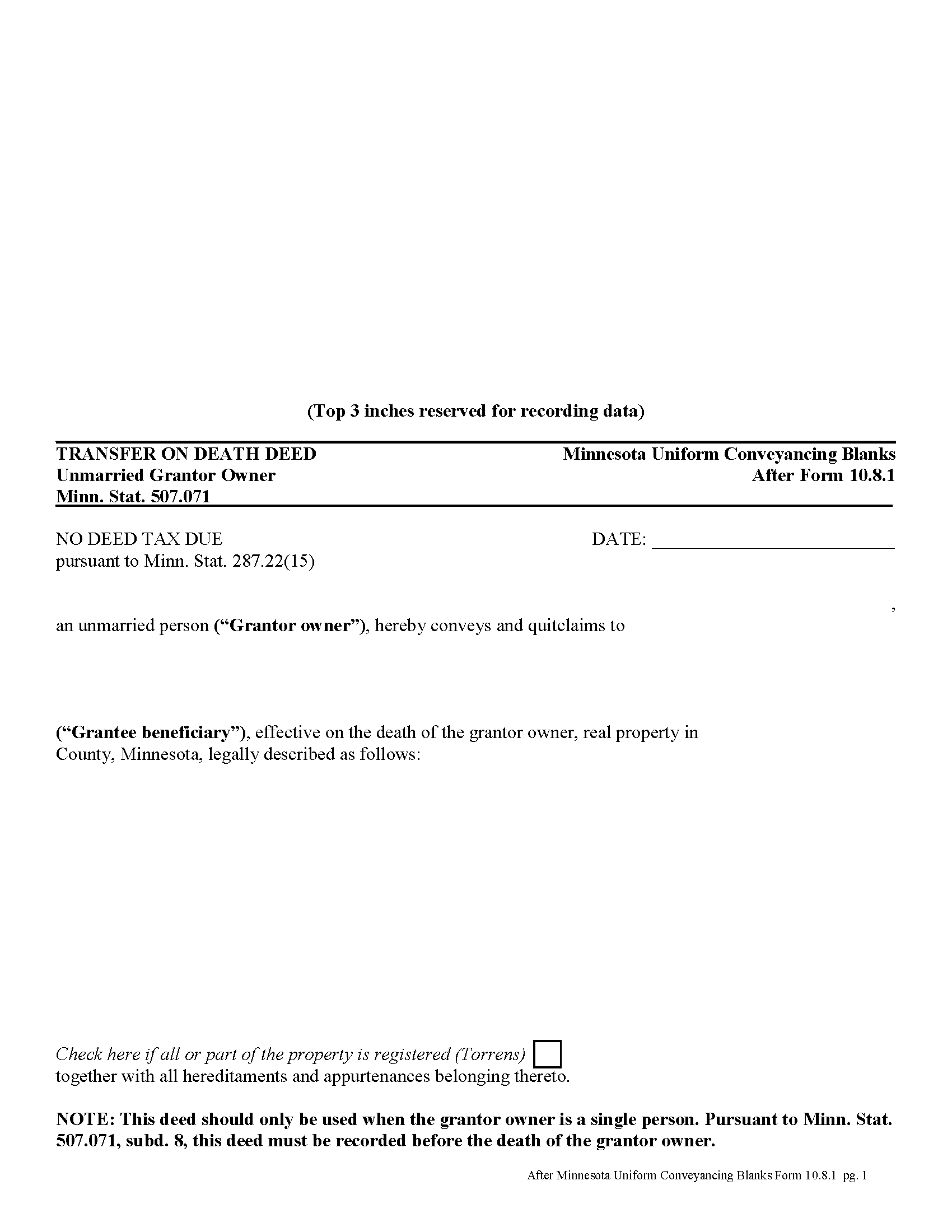
Transfer on Death Deed by Unmarried Grantor Owner -- Minnesota Form 10.8.1
In Minnesota, transfer on death deeds are governed by Minn. Stat. 507.071.
While the statute provides a basic form, as well as overall content requirements, the state authorized the development of uniform conveyance documents for some specific situations. For example, to add clarity, there is a form specifically designed for use by unmarried grantor owners. A correctly-completed basic statutory form is valid in most cases, but it asks for information that may not apply to a single individual. By providing incorrect or conflicting information, even if it is unnecessary, the grantor owner might inadvertently cause the property to revert to the deceased owner's estate for probate distribution.
This transfer on death deed form is for use ONLY by unmarried grantor owners.
As with other transfer on death deeds, this form must be executed and RECORDED during the grantor owner's lifetime.
(Minnesota TOD Deed by Unmarried Owner Package includes form, guidelines, and completed example)... More Information about the Minnesota Transfer on Death Deed by Unmarried Owner
Trustee Deed Individual
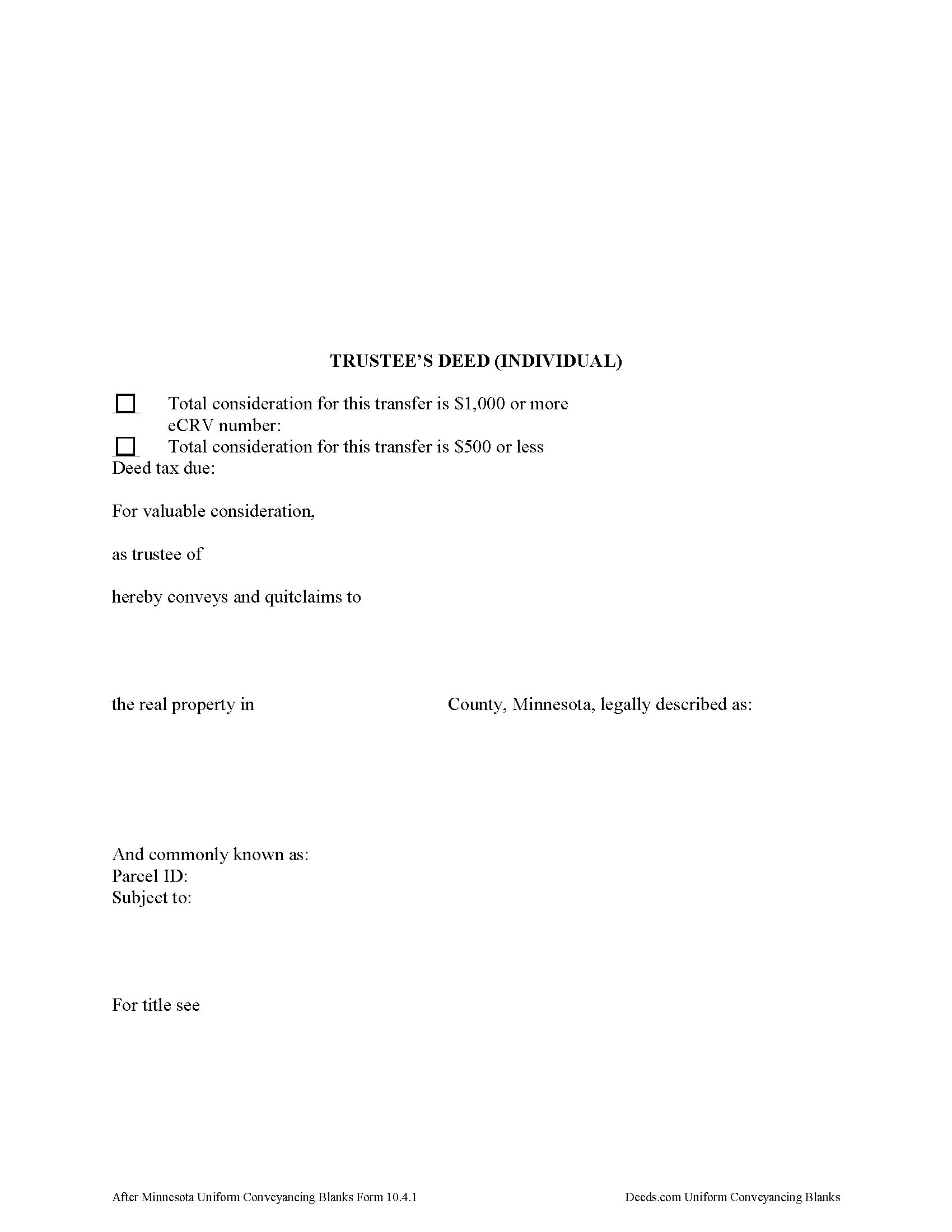
What's in a Minnesota Trustee's Deed?
Minnesota allows for two main types of trustees deeds: one between individuals, and one for use by business entities. The primary differences between the two forms are that the deed intended for businesses contains details about the corporate entity and the laws under which it was formed, and a corporate notary acknowledgement, while the form for individuals does not require that information. This article focuses on the trustee's deed for individuals.
A trustee's deed conveys title to real property held in a non-testamentary trust. The deed is named for the executing trustee, unlike other deed forms, which are named for the warranties of title they contain. Trustees are authorized to sell property under Minn. Stat. 501C.0816.
In a trust arrangement, the trustee holds legal title to property conveyed to the trust by the settlor, for the benefit of the trust's beneficiaries. A beneficiary is someone with a present or future interest in the trust (Minn. Stat. 501C. 0103). The settlor establishes the provisions of the trust, including the designation of a trustee and a trust beneficiary, in the trust instrument, which typically is not ... More Information about the Minnesota Trustee Deed Individual
Affidavit of Trustee for Testamentary Trust
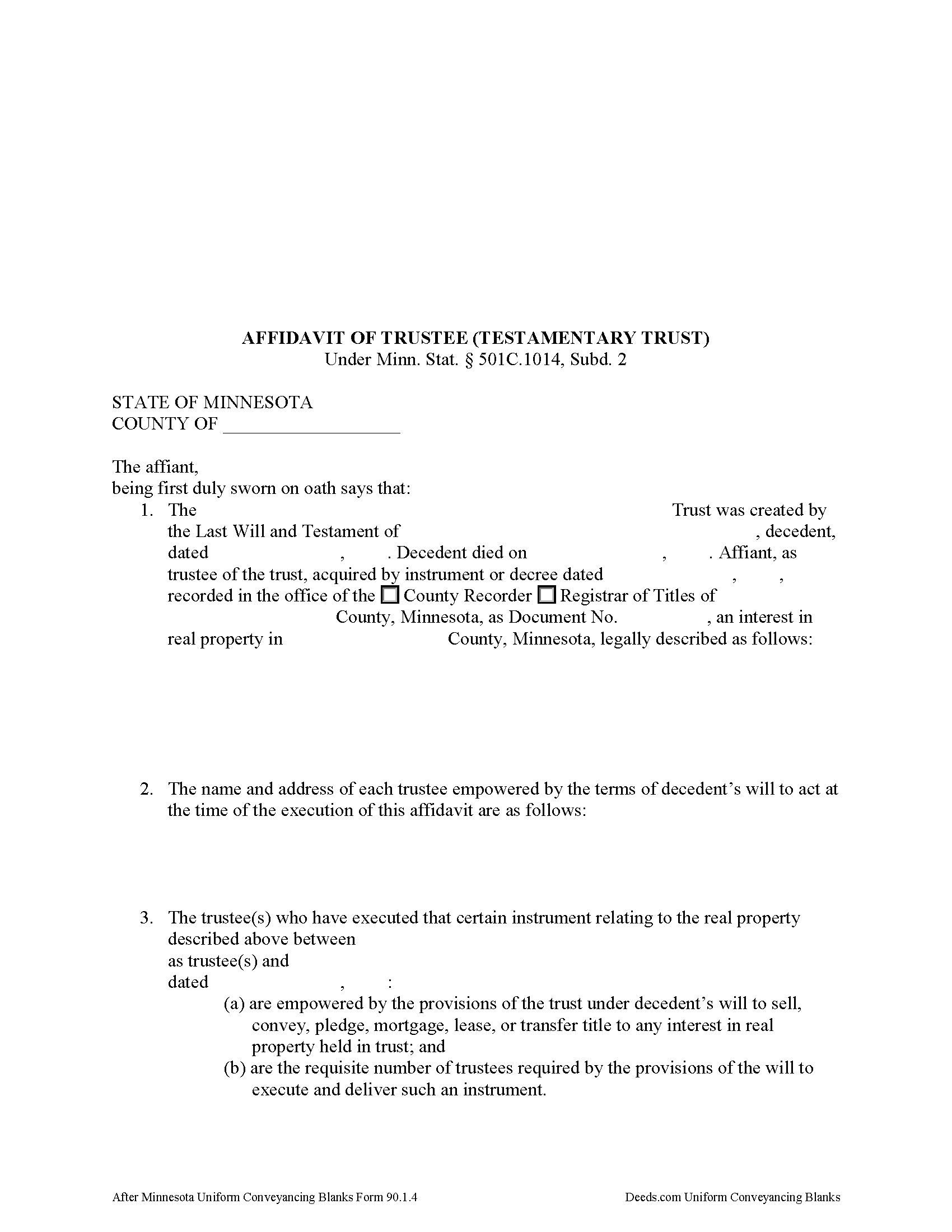
An affidavit of trustee contains sworn statements made by a trustee and relating to a specific transaction involving real property contained by the trust. The affidavit of trustee for a testamentary trust is codified at Minn. Stat. 501C.1014, Subd. 2.
A testamentary trust is a trust created by a will that takes effect upon the death of a testator. The affidavit of trustee for a testamentary trust, then, references the name of the trust and the date of the will under which it was created, as well as the decedent's name and date of death. It also references the instrument granting the trusteeship, including the date and place of recording.
The affidavit must contain a full legal description of the property subject to the transaction for which the affidavit is presented. It references the trustee and other party involved in the transaction and offers proof that the required number of trustees are entering the transaction and that the trustees are authorized under the decedent's will to act on the title to the real property held in the trust, and that there are no trust amendments that limit the power of the trustees.
The affiant confirms that the trust has not terminated ... More Information about the Minnesota Affidavit of Trustee for Testamentary Trust
Affidavit of Trustee for Non-testamentary Trust
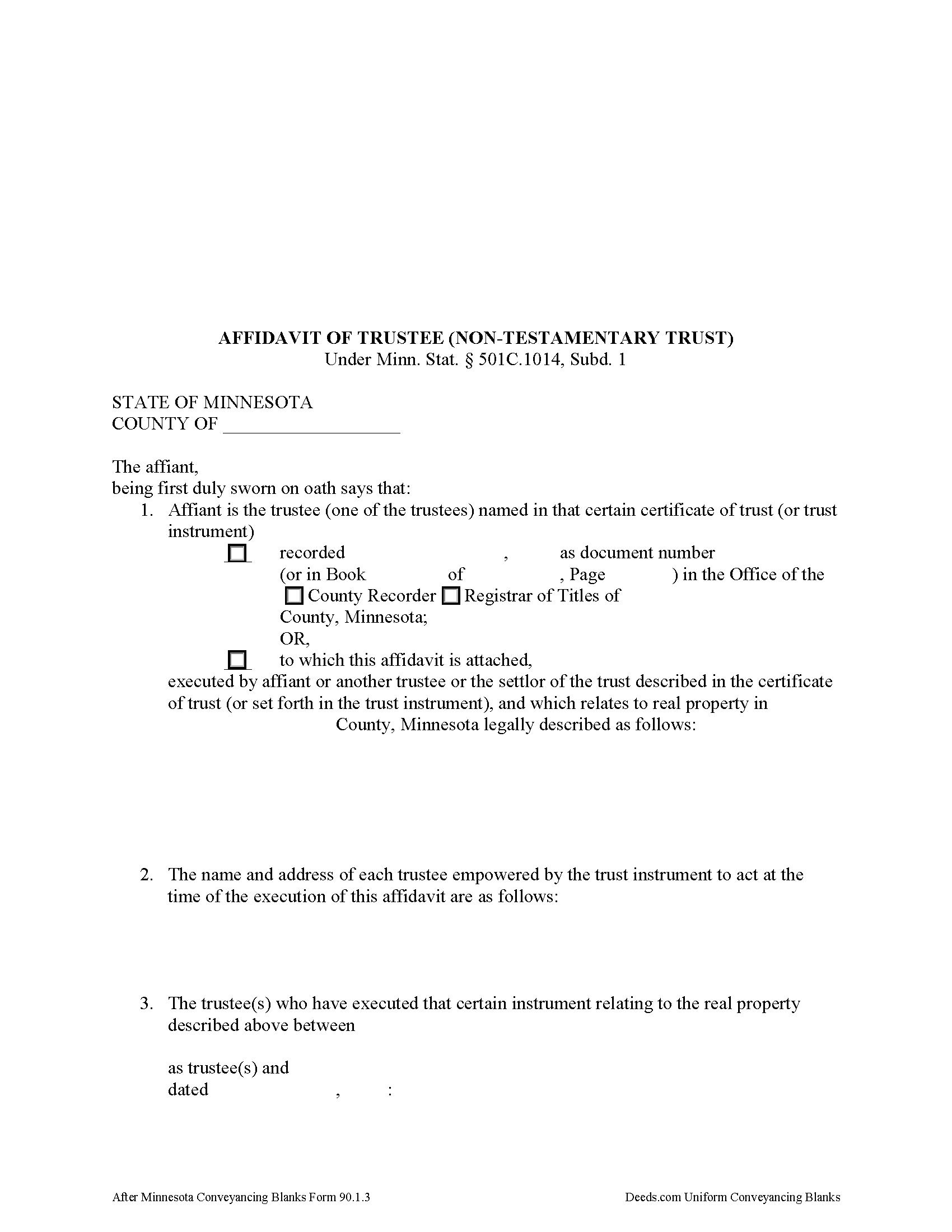
An affidavit of trustee contains sworn statements made by a trustee and relating to a specific transaction involving real property contained by the trust. The affidavit of trustee for a non-testamentary trust is codified at Minn. Stat. 501C.1014, Subd. 1.
A non-testamentary trust, also called an inter vivos or living trust, is a trust that takes effect during a settlor's lifetime. A settlor is "a person, including a testator, who creates or contributes property to a trust" (Minn. Stat. 501C.0103(o)). The affidavit of trustee for a non-testamentary trust references a recorded certificate of trust, including the recording date and location, or states that the affidavit is attached to the certificate, and confirms that the certificate was executed by the affiant, another trustee, or the settlor of the trust described in the certificate and relating to the specific parcel of land described in the affidavit.
The affidavit must contain a full legal description of the property subject to the transaction for which the affidavit is presented. It references the trustee and other party involved in the transaction, and offers proof that the required number of trustees are entering the... More Information about the Minnesota Affidavit of Trustee for Non-testamentary Trust
Correction Deed
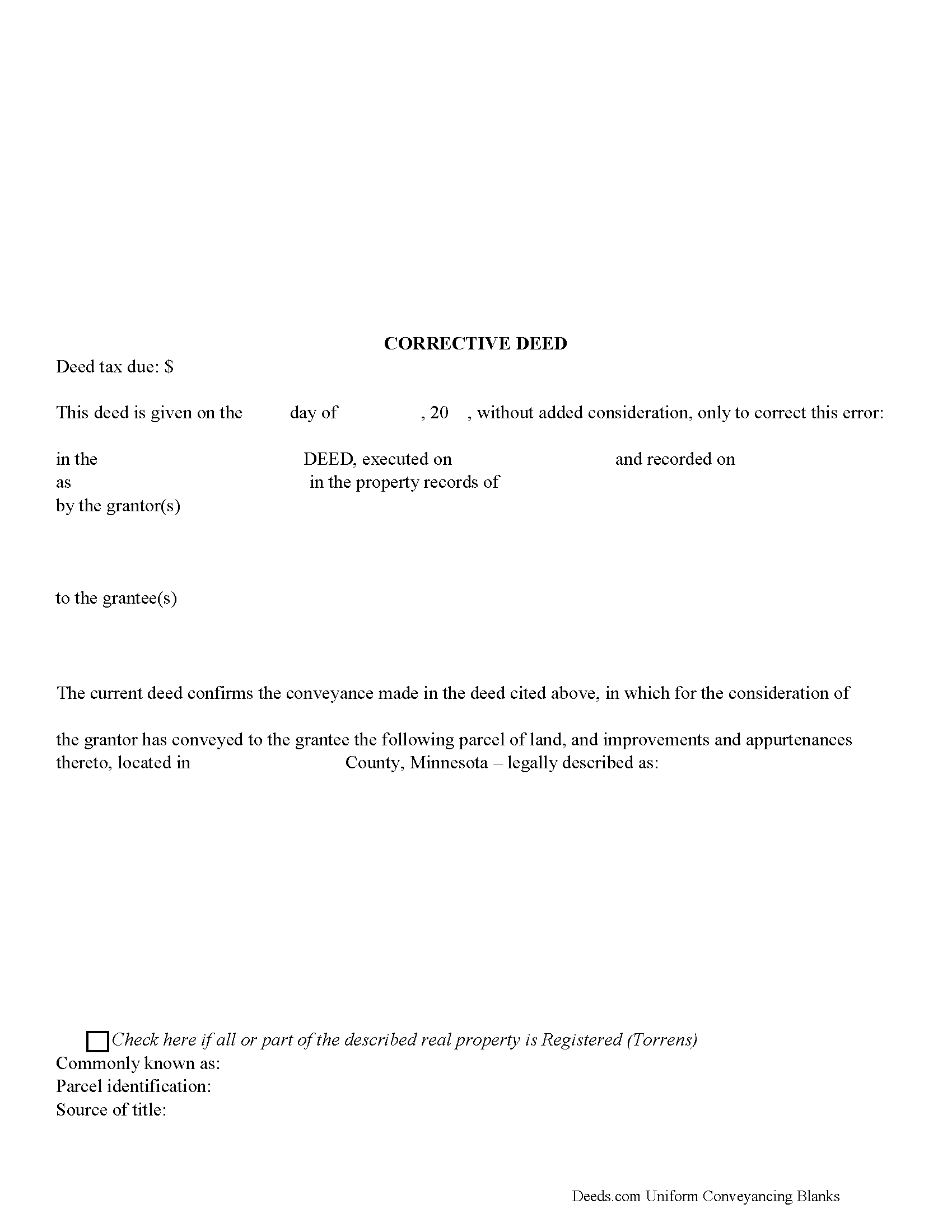
Use the corrective deed to amend a previously recorded deed of conveyance with an error that could affect the title.
In Minnesota, there are two options for correcting a deed, re-recording the corrected original deed and recording a newly drafted corrective deed. When re-recording the original deed, make corrections directly on the document, but keep in mind that legal documents cannot be altered with strikeout, whiteout, line through or correction tape. Check with the county's recording office before choosing this option to verify local requirements regarding title pages, required attachments and how to handle the correcting itself.
A re-recorded document must be re-signed by the original parties and re-acknowledged and contain a correction statement that gives the reason for the re-recording and refers to the prior recording. Keep in mind that adding extra pages for the various required statements and the signatures will increase the overall page count of the re-recording, which may affect recording fees.
The easiest and cleanest option is to record a new corrective deed, which mostly restates the prior deed, but also contains the reason for the correction, reference to... More Information about the Minnesota Correction Deed
Mineral Deed
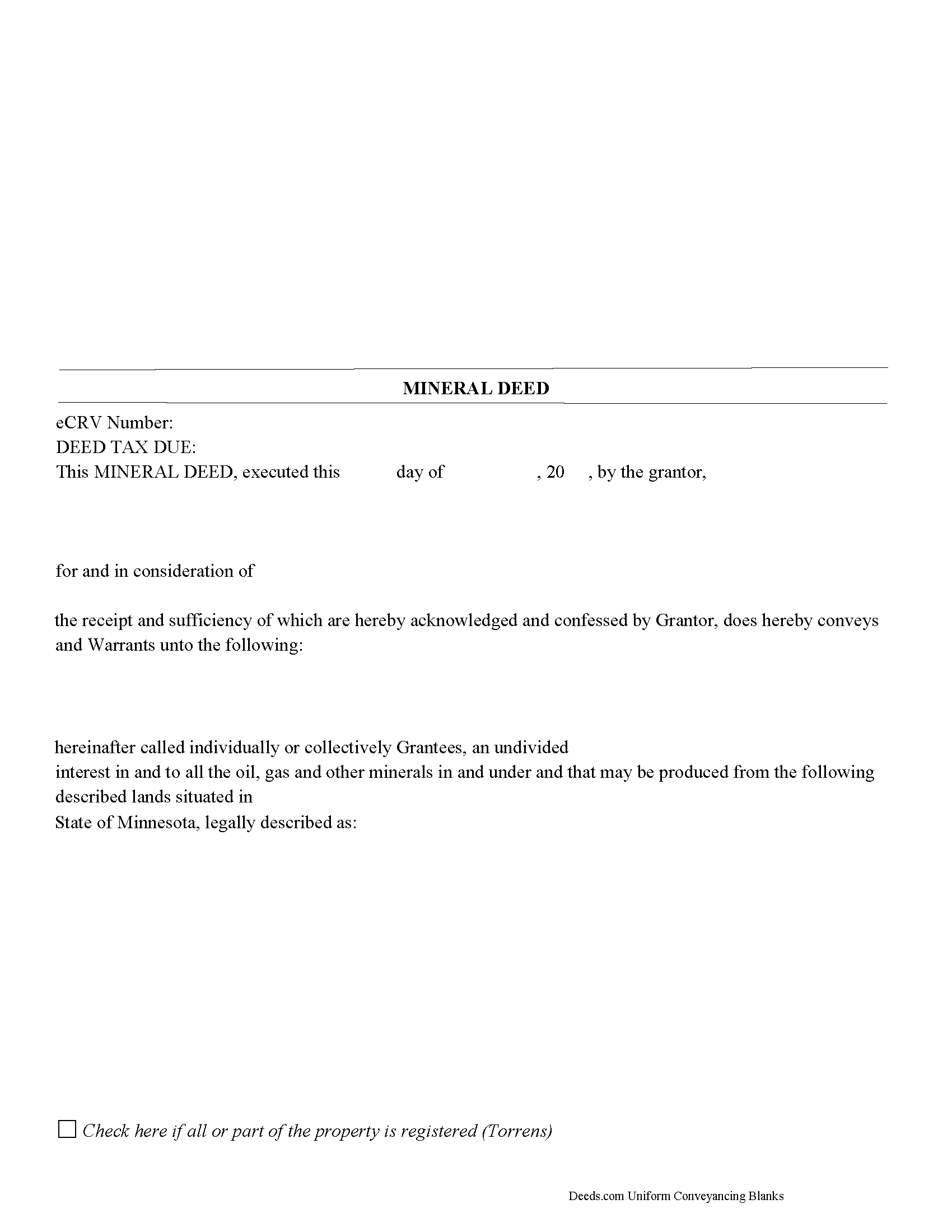
The General Mineral Deed in Minnesota transfers oil, gas, and mineral rights from the grantor to the grantee. THIS IS NOT A LEASE. There are no Exceptions or Reservations included.
The transfer includes the oil, gas and other minerals of every kind and nature. It also transfers any and all rights to receive royalties, overriding royalties, net profits interests or other payments out of or with respect to those oil, gas and other minerals. The Grantor can stipulate the percentage of Mineral Rights the Grantee will receive and is made subject to any rights existing under any valid and subsisting oil and gas lease or leases of record.
This general mineral deed gives the grantee the right to access, for the purpose of mining, drilling, exploring, operating and developing said lands for oil, gas, and other minerals, and storing handling, transporting and marketing of such.
In this document the Grantor Warrants and will defend said Title to Grantee. Use of this document has a permanent effect on your rights to the property, if you are not completely sure of what you are executing seek the advice of a legal professional.
(Minnesota MD Package includes form, guidelines, and com... More Information about the Minnesota Mineral Deed
Mortgage Secured by Promissory Note
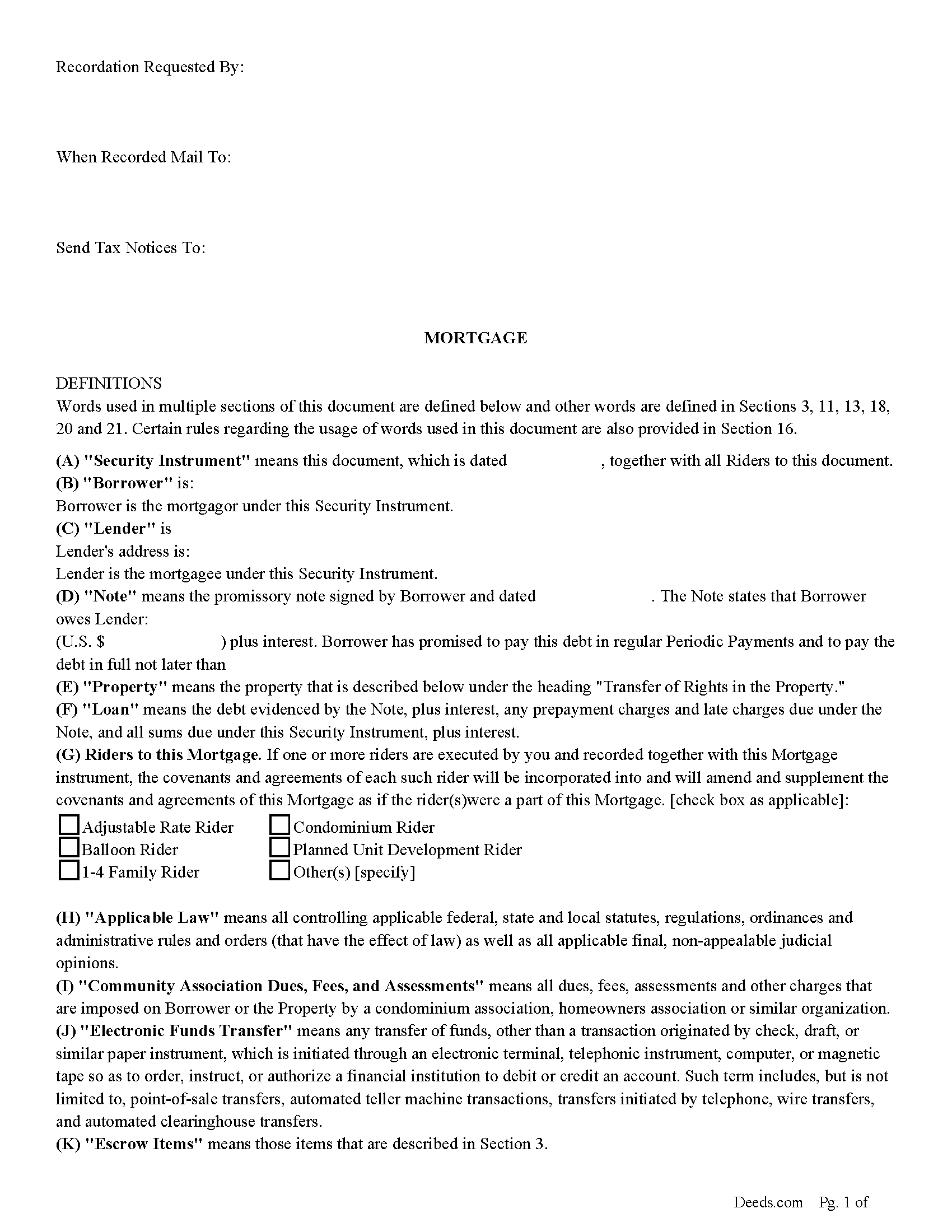
This is a recordable document, when (properly recorded shall be taken and deemed notice to parties.) (507.32 Record, When Notice to Parties; Assignment of Mortgage.)
No instrument by which the title to real estate or any interest therein or lien thereon, is conveyed, created, encumbered, assigned or otherwise disposed of, shall be recorded by the county recorder or registered by the registrar of titles until the name and address of the person who or corporation which drafted the instrument is printed, typewritten, stamped or written on it in a legible manner.
(507.091 Conveyance to Include Name and Address of Drafter)
(No contract for deed or deed conveying fee title to real estate or affidavit of survivorship shall be recorded by the county recorder or registered by the registrar of titles until the name and address of the person to whom future tax statements should be sent, is printed, typewritten, stamped or written on it in a legible manner.) 507.092 Conveyance to Include Name and Address of Person to Receive Tax Statements.
Use this comprehensive 12 page Mortgage Form for vacant land, residential property, rental property (up to 4 units), small commercial property, c... More Information about the Minnesota Mortgage Secured by Promissory Note
Subcontractor Notice of Furnishing
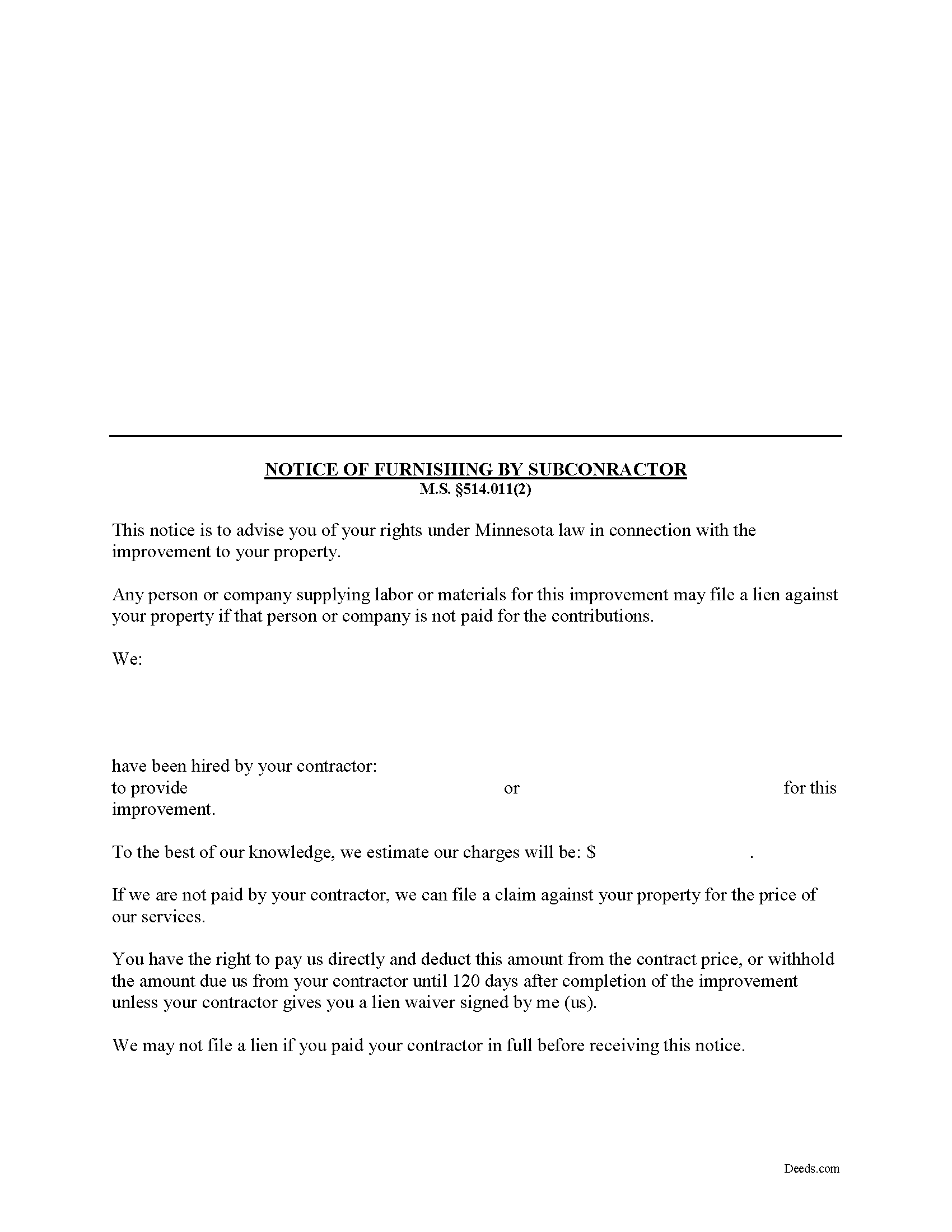
What notice must a subcontractor give to protect lien rights in Minnesota?
Notice is a key element to the substance of mechanic's lien law. To successfully maintain an action for a mechanic's lien, a lien claimant must strictly comply with the notice requirements. In Minnesota, subcontractors, or contractors not in direct written contract with the owner, must provide the proper pre-lien notice. Subcontractors in this state may use a notice form known as the "Subcontractor's Notice of Furnishing."
Under the State's law, every person who contributes to the improvement of real property, except a party under direct contract with the owner must, as a necessary pre-condition to claiming a lien, give the owner or the owner's authorized agent a written notice of furnishing, no later than 45 days after the lien claimant has first furnished labor, skill or materials for the improvement. M.S. 514.011(2)(a). The notice must be delivered either by personal delivery or certified mail. Id. For the purposes of the statute, "owner" means the owner of any legal or equitable interest in the real property whose interest in the property: (1) is known to one who contributes to the improvement of t... More Information about the Minnesota Subcontractor Notice of Furnishing
Mechanics Statement of Lien
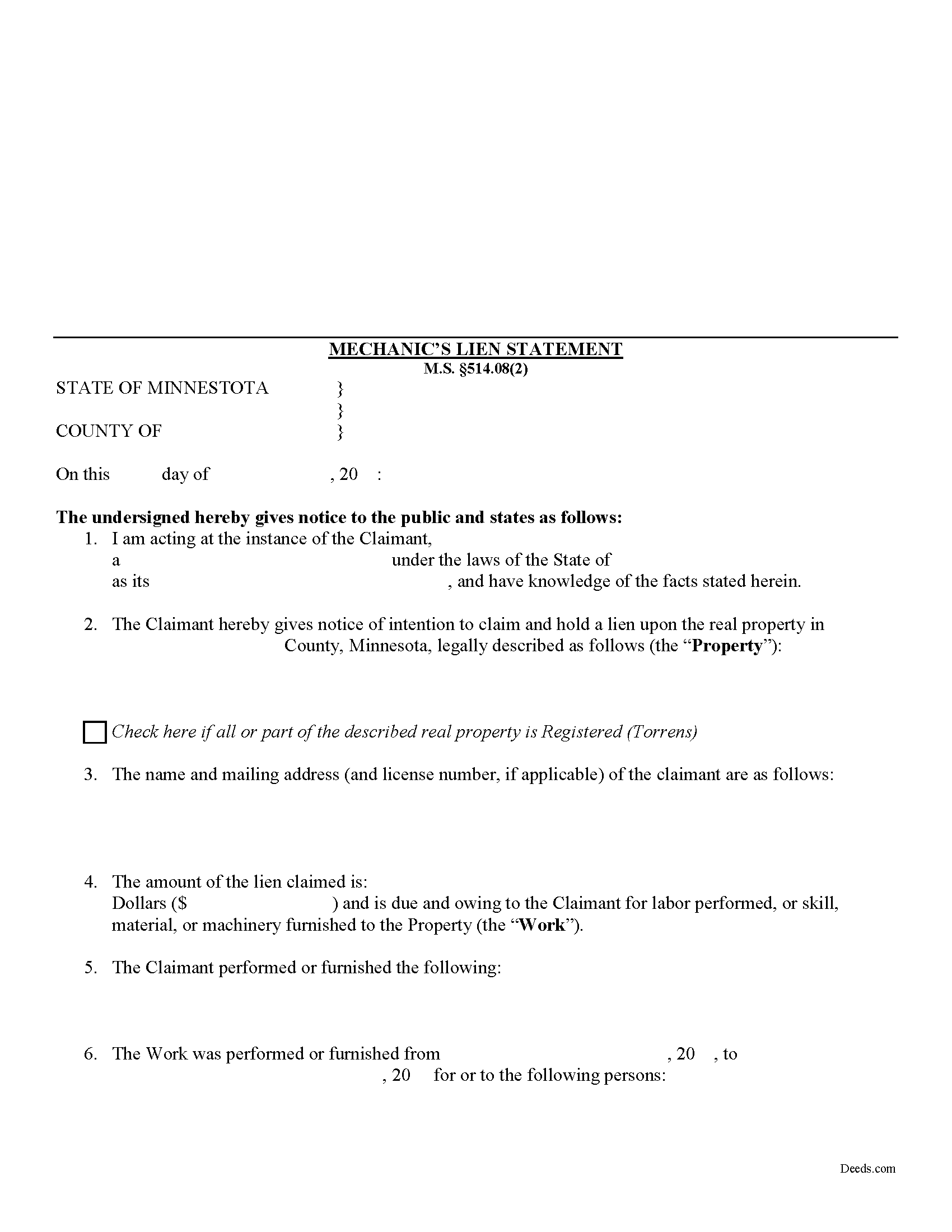
Recording a Statement of Lien in Minnesota
Claims for mechanic's liens are used to recover unpaid balances for services rendered or materials delivered by placing an encumbrance (block) on the owner's title until the owner pays up and the claimant grants the owner a release. To obtain a mechanic's lien in Minnesota, claimants draft and record a form called a "Statement of Lien," but only after giving the required preliminary (pre-lien) notice to the property owner and other interested parties within 45 days of first starting the work or delivering any materials. M.S. 514.011.
The lien statement must be made by or at the instance of the lien claimant and be verified by the oath of some person shown by the verification to have knowledge of the facts stated. M.S. 514.08(2). The lien statement contains the following information: (1) a notice of intention to claim and hold a lien, and the amount thereof; (2) that such amount is due and owing to the claimant for labor performed, or for skill, material, or machinery furnished, and for what improvement the same was done or supplied; (3) the names of the claimant, and of the person for or to whom performed or furnished; (4) the dates ... More Information about the Minnesota Mechanics Statement of Lien
Receipt and Waiver of Mechanic Lien
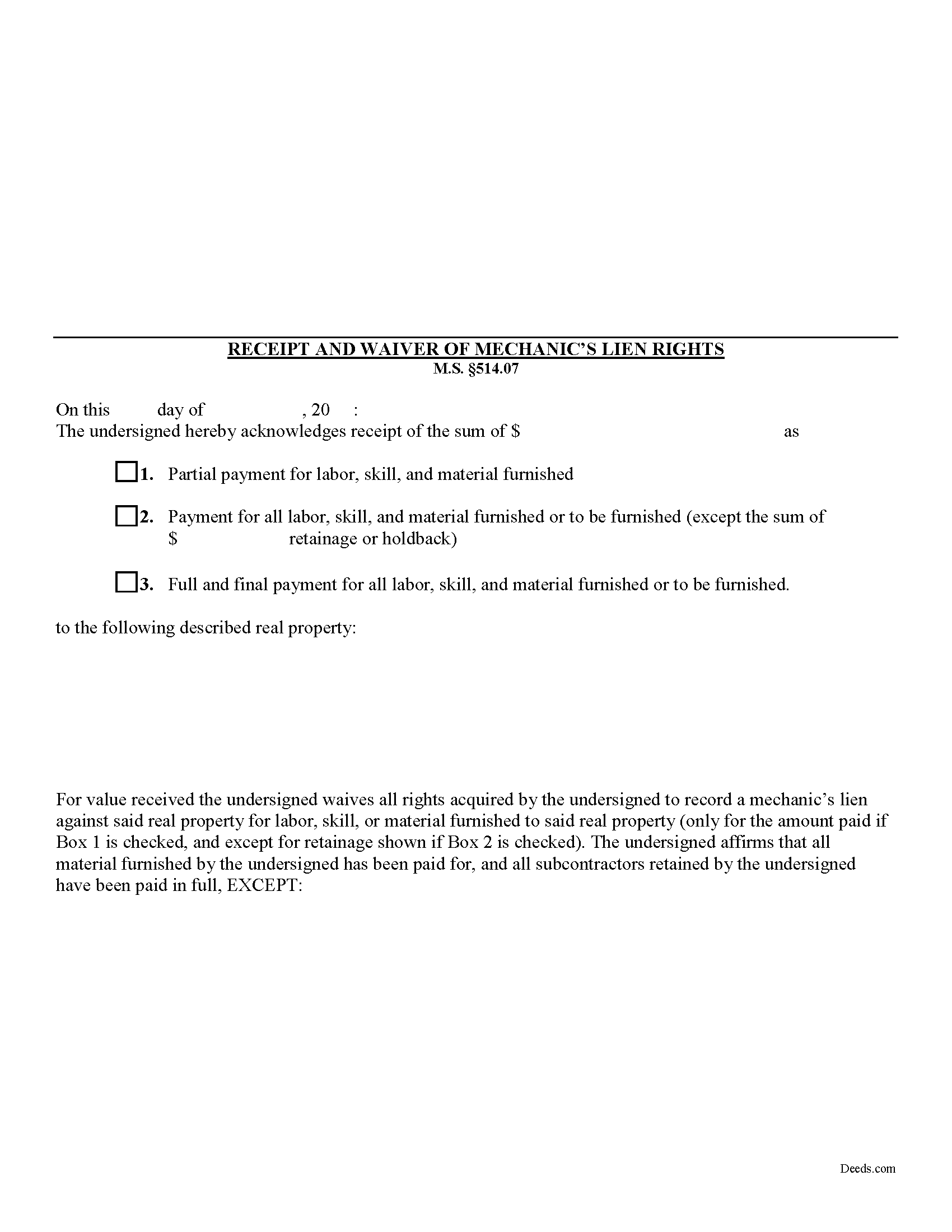
Receipt and Waiver of Mechanic's Liens Rights in Minnesota
During the construction process, the owner (or other parties) may make one or more progress or partial payments on the work or materials furnished to date. Additionally, the owner might pay the full amount or the full amount less any retainage or holdback amounts (used to pay subs and other worker's wages). When a full or partial payment is made, you can issue the owner a waiver for a lien on the amount paid. By issuing the waiver, you give up the right to claim a mechanic's lien for either the full or partial payment amount.
The receipt and waiver contains the following information: 1) date drafted; 2) amount received as full or partial payment; 3) a designation as partial payment for labor, skill, and material furnished; payment for all labor, skill, and material furnished or to be furnished; or full and final payment for all labor, skill, and material furnished or to be furnished; 4) if there are exceptions for amounts for retainage or holdback, the total amounts withheld; and 5) a property description; and 6) description of all materials not yet paid for or names of contractors not yet paid.
Finally, you shoul... More Information about the Minnesota Receipt and Waiver of Mechanic Lien
Assignment of Mechanic Lien
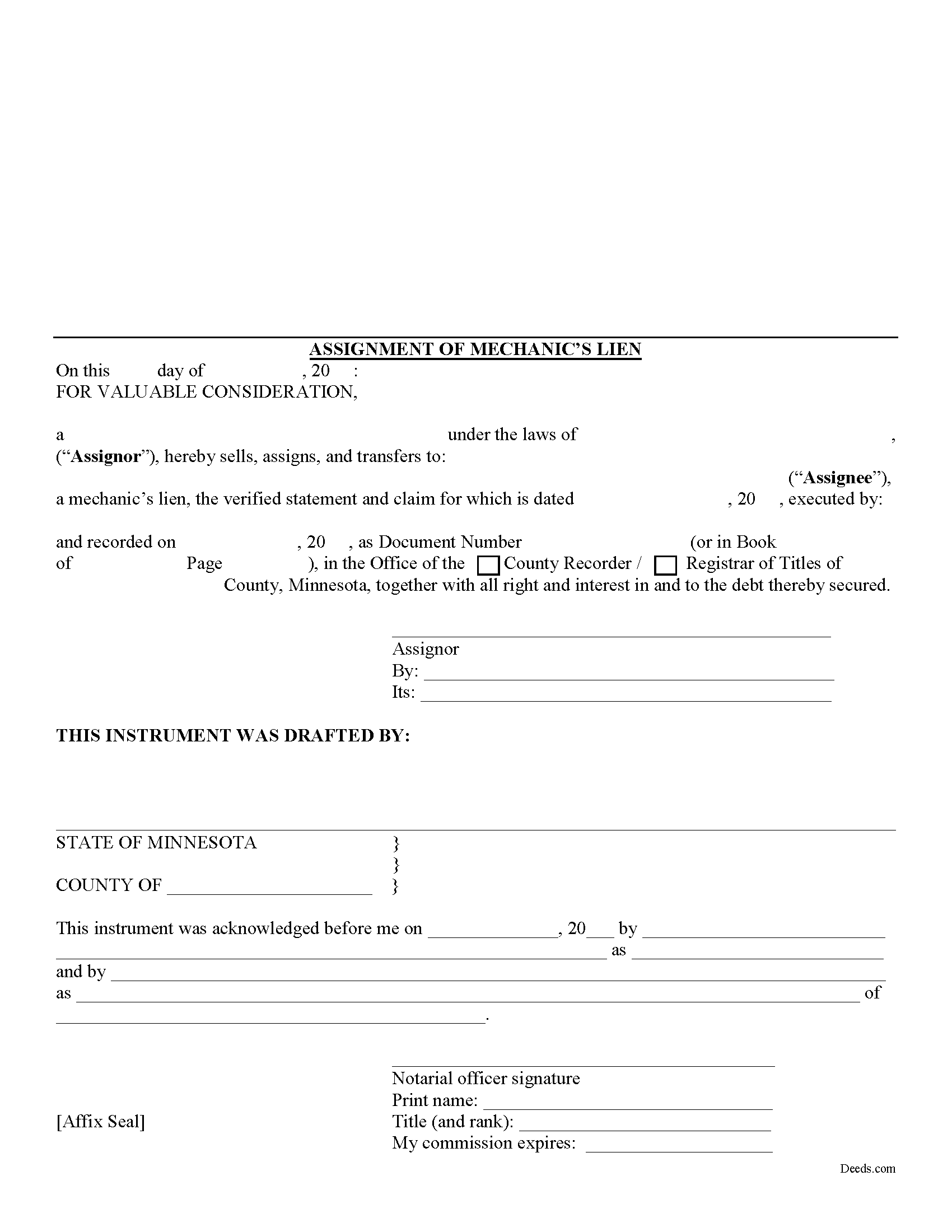
One of the fundamental principles of contract law is the right to assign contract rights to a third party. This is a corollary to the principle of "delegation," which involves assigning the duties under a contract to a third party. For example, Jack contracts with Jill to build Jill a house. Jack then assigns the right to payment for the house to Fred (maybe he owes Fred some money on a debt). This is called an "assignment." Contrast that with if Jack were to enlist Fred to build the house for Jill to fulfill Jack and Jill's contract, this would be a "delegation" (although possibly not a legal one if Jill entered the agreement specifically to seek Jack's special services). With the basic legal terminology clarified, let's move on to how lien assignments work in Minnesota.
Lien assignments work like any other assignments of rights under other types of contracts. Therefore, they are governed under Minnesota's version of the Uniform Commercial Code which is codified under Chapter 336 of the Minnesota Statutes.
Under the Commercial Code's rule on assignments, all rights of either seller or buyer can be assigned except where the assignment would materially change the duty of the o... More Information about the Minnesota Assignment of Mechanic Lien
Satisfaction of Mechanic Lien
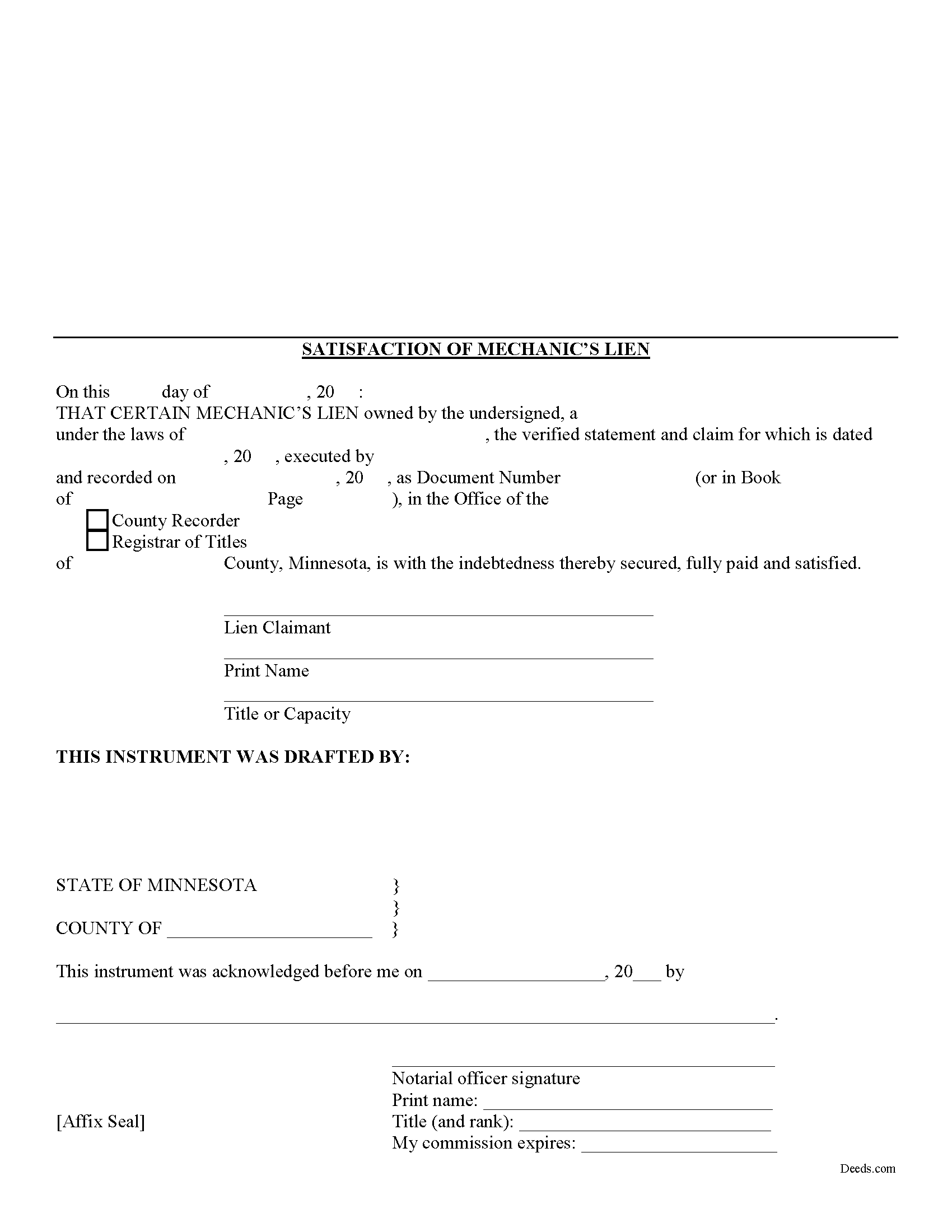
The Minnesota construction lien law doesn't set forth a specific provision for the satisfaction of a lien. Therefore, any form sufficient to identify the lien and the lien holders intention of releasing it, will allow a lien holder to provide notice that the lien is released after receiving payment in full.
The Satisfaction of Lien contains information identifying the lien claimant and the recorded mechanic's lien (such as the date recorded, office recorded, document number, book number, and page number). The Satisfaction of Lien should be recorded at the public records office or registrar of deeds (for Torrens title property).
This article is provided for informational purposes only and should not be relied upon as a substitute for the advice of an attorney. Please consult a Minnesota attorney with any questions about the Satisfaction of Mechanic's Lien or other related issues.... More Information about the Minnesota Satisfaction of Mechanic Lien
Release of Mechanic Lien
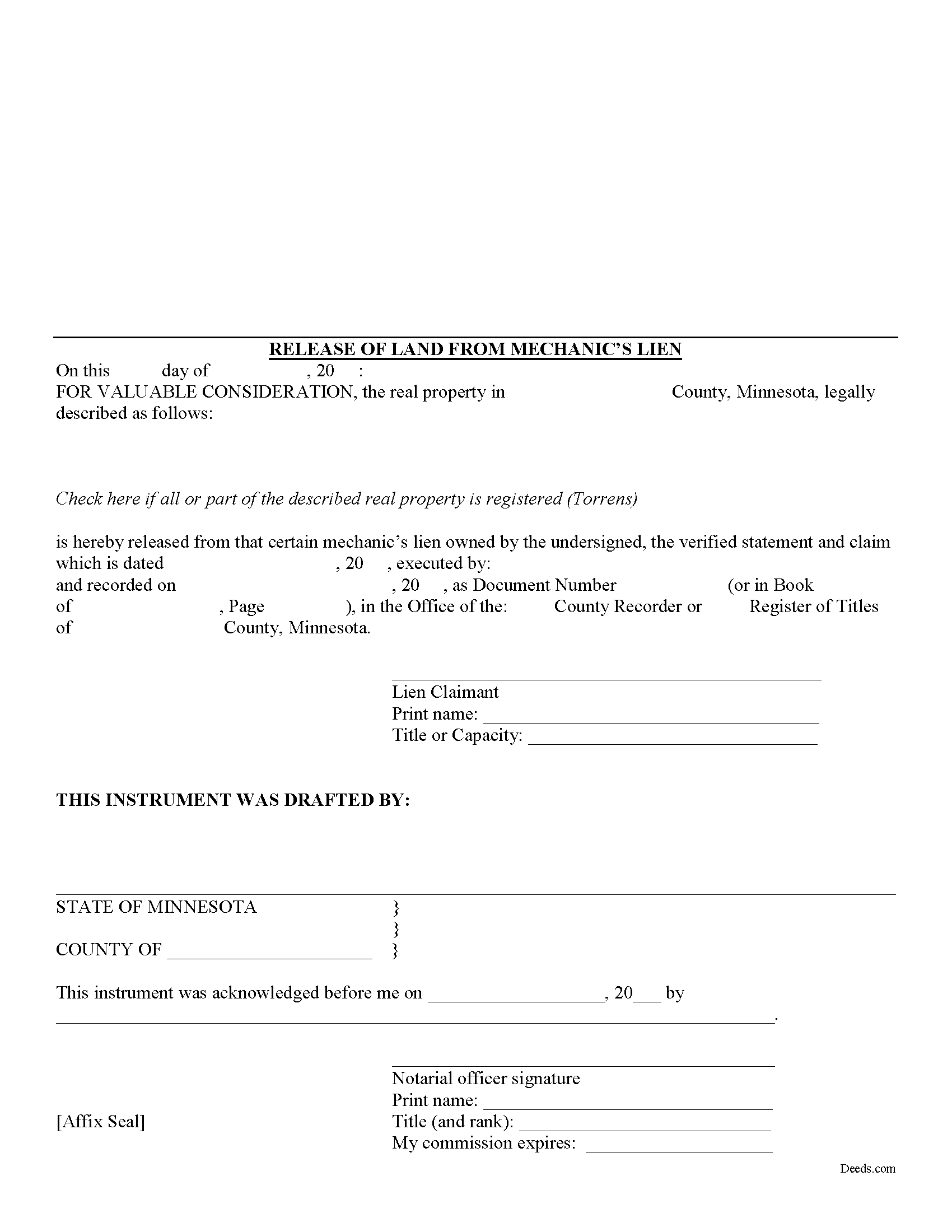
Releasing Land from a Mechanics Lien
The Minnesota construction lien law doesn't set forth a specific provision for the release of a lien. Therefore, any form sufficient to identify the lien, the subject property, and the lien holder's intention of releasing it from a previously filed lien, will allow a lien holder to provide notice that the lien is released.
The Release of Land from Mechanic's Lien contains information identifying the lien claimant and the recorded mechanic's lien (such as the date recorded, office recorded, document number, book number, and page number), and the subject property. The Release should be recorded at the public records office or registrar of deeds (for Torrens title property).
This article is provided for informational purposes only and should not be relied upon as a substitute for the advice of an attorney. Please consult a Minnesota attorney with any questions about the Release of Land from Mechanic's Lien, or other issues related to liens.... More Information about the Minnesota Release of Mechanic Lien
Disclaimer of Interest
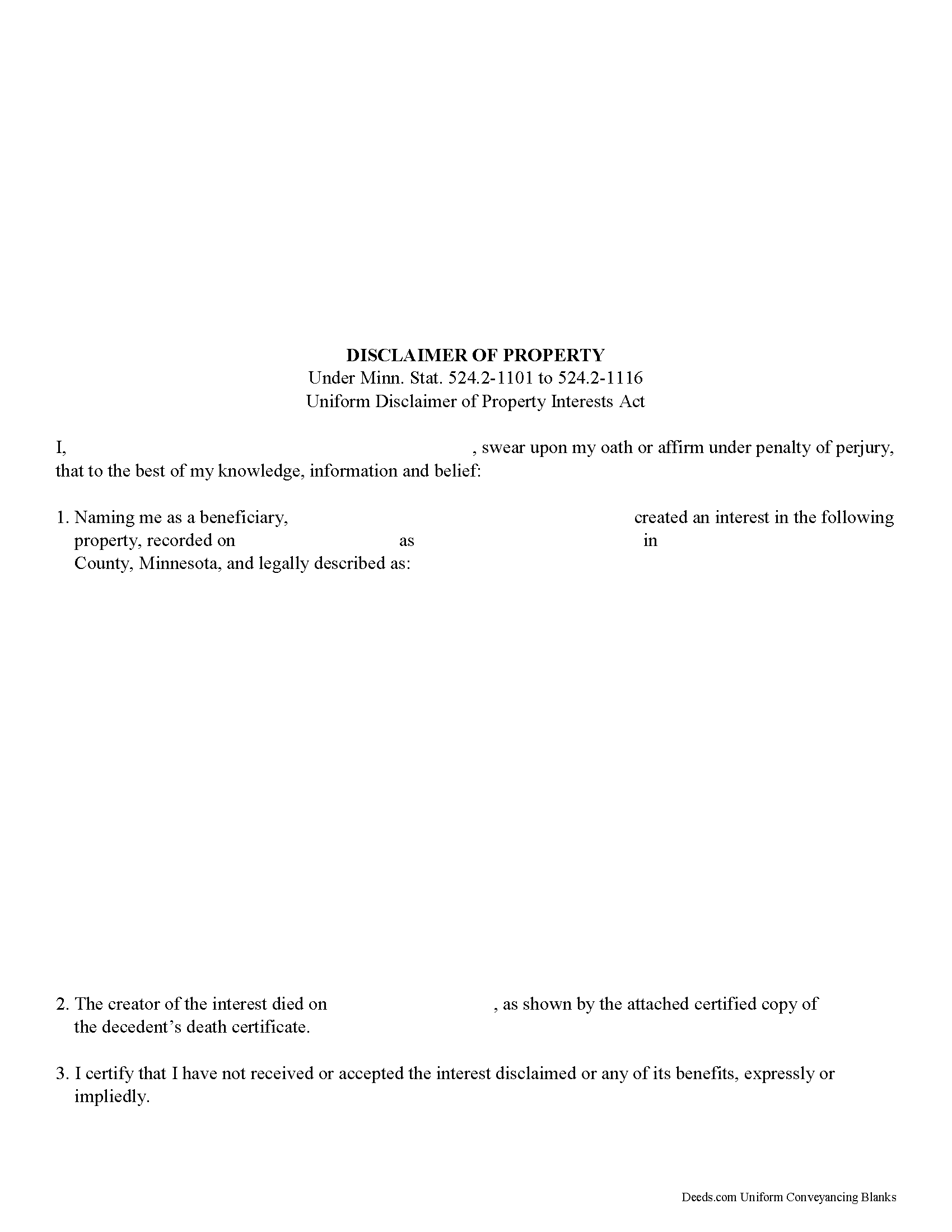
Under the Minnesota statutes, the beneficiary of an interest in property may renounce the gift, either in part or in full (Minn. Stat. 524.2-1101 to 524.2-1116 Uniform Disclaimer of Property Interests Act). Note that the option to disclaim is only available to beneficiaries who have not acted in any way to indicate acceptance or ownership of the interest.
The disclaimer must be in writing and include a description of the interest, a declaration of intent to disclaim all or a defined portion of the interest, and be signed by the disclaimant (Minn. Stat. 524.2-1107 (c)).
Deliver the disclaimer within nine months of the transfer (e.g., the death of the creator of the interest) to the personal representative of the decedent's estate, or file it with the clerk of the court in any county where administration of estate might proceed (524.2-1114 (b)). In the case of real property, record a copy of the disclaimer in the office of the county recorder or the registrar of titles in the county or counties where the real estate is located (524.2-1115).
A disclaimer is irrevocable and binding for the disclaiming party and his or her creditors, so be sure to consult an attorney when i... More Information about the Minnesota Disclaimer of Interest
Certificate of Trust
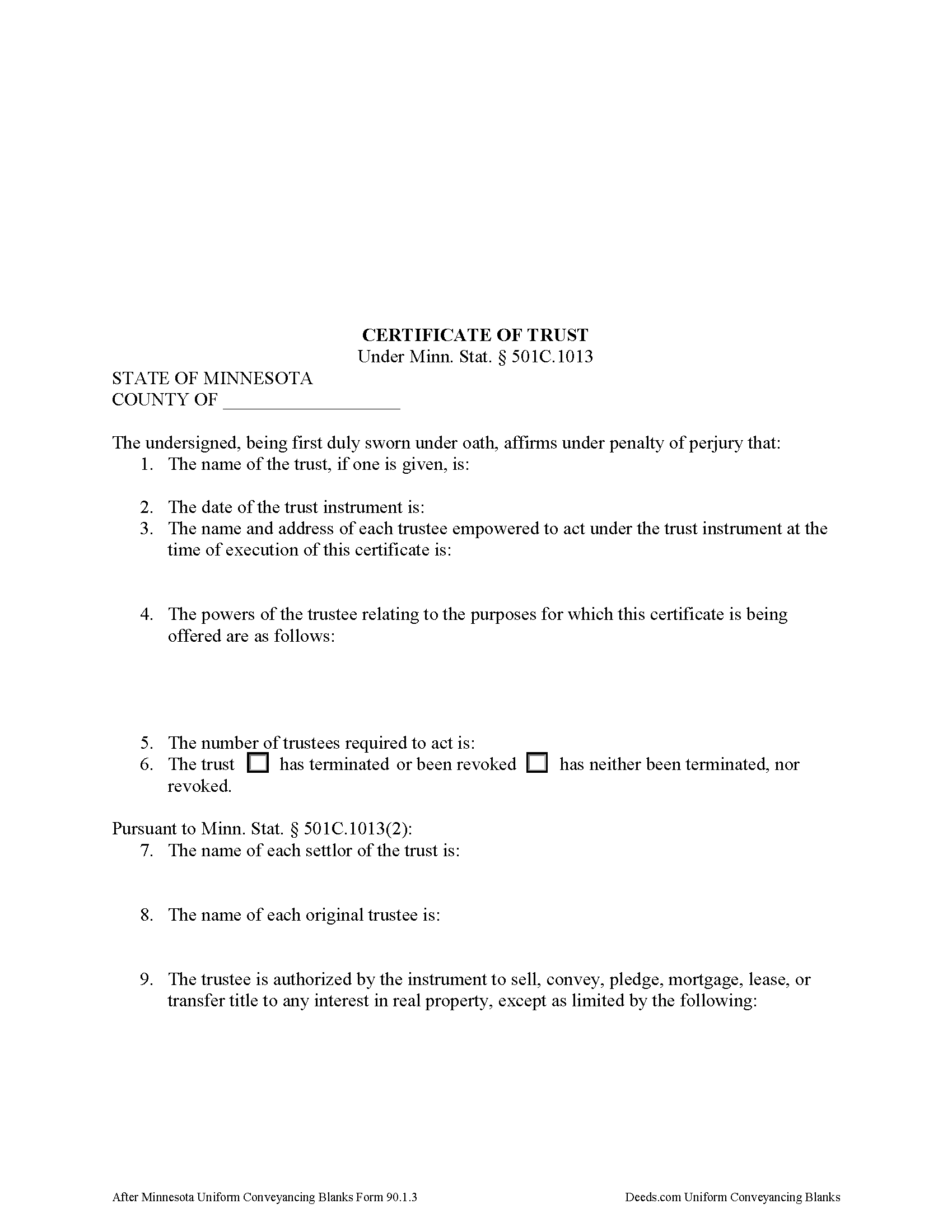
The certificate of trust is codified under the Minnesota Trust Code at Minn. Stat. 501C.1013.
This document is an abstract of the trust instrument setting forth "fewer than all of the provisions . . . and any amendments to the instrument," and contains only essential information relevant to the transaction for which it is being presented (Minn. Stat. 501C.1013, Subd. 1). It "serves to document the existence of the trust, the identity of the trustees, the powers of the trustees and any limitations on those powers, and other matters the certificate of trust sets out, as though the full trust instrument had been recorded or presented" (Subd. 4).
Presented to a recipient in situations regarding personal property, or filed with the county recorder in situations regarding real property, a certificate of trust is "prima facie proof as to matters contained in it" (Subd. 4).
A certificate is valid when executed by settlor or trustee "any time after the execution or creation of a trust" (Subd. 1). The basic content requirements include the name of the trust; the date of the trust instrument; the name and address of each acting trustee; the number of trustees required to act; and... More Information about the Minnesota Certificate of Trust